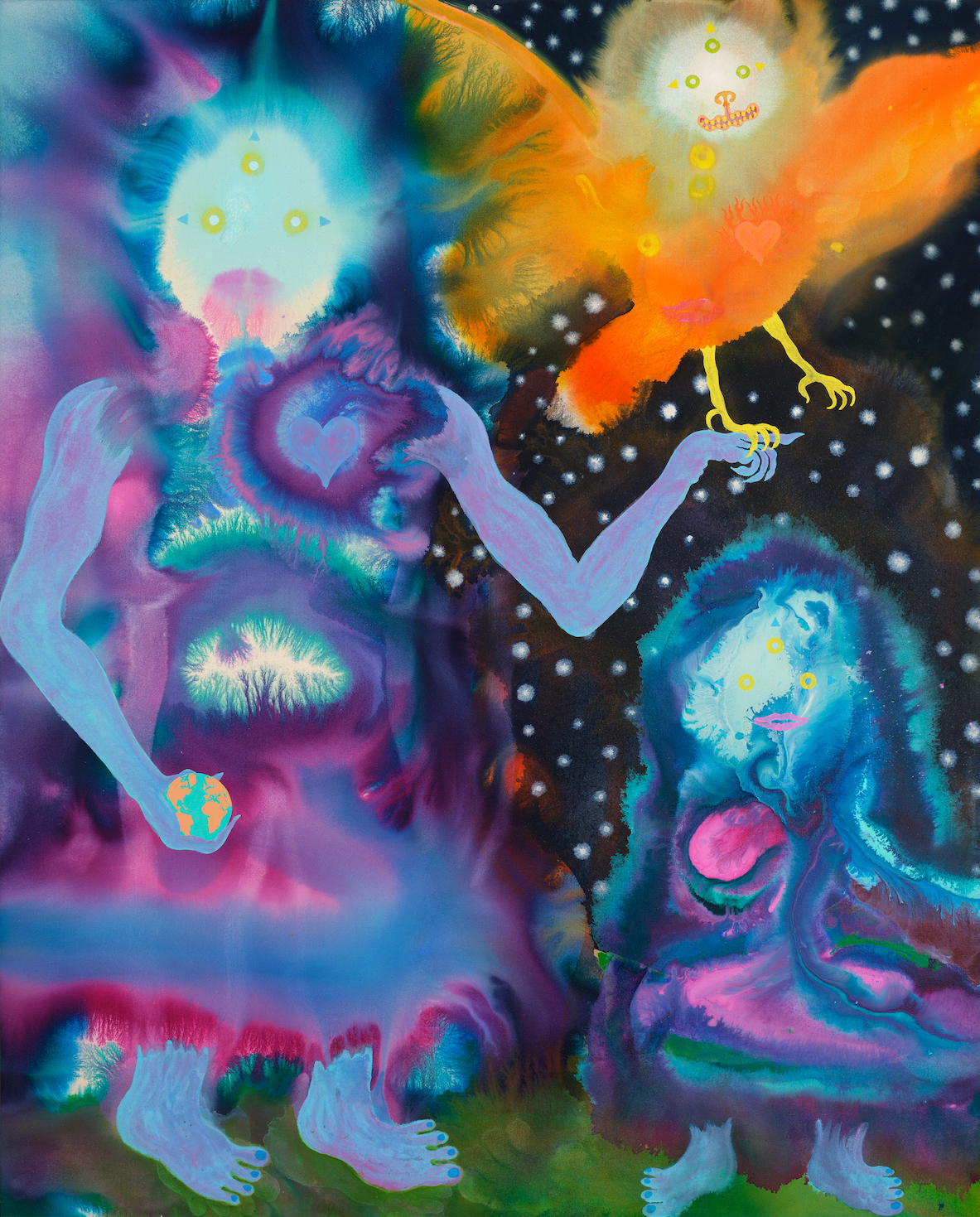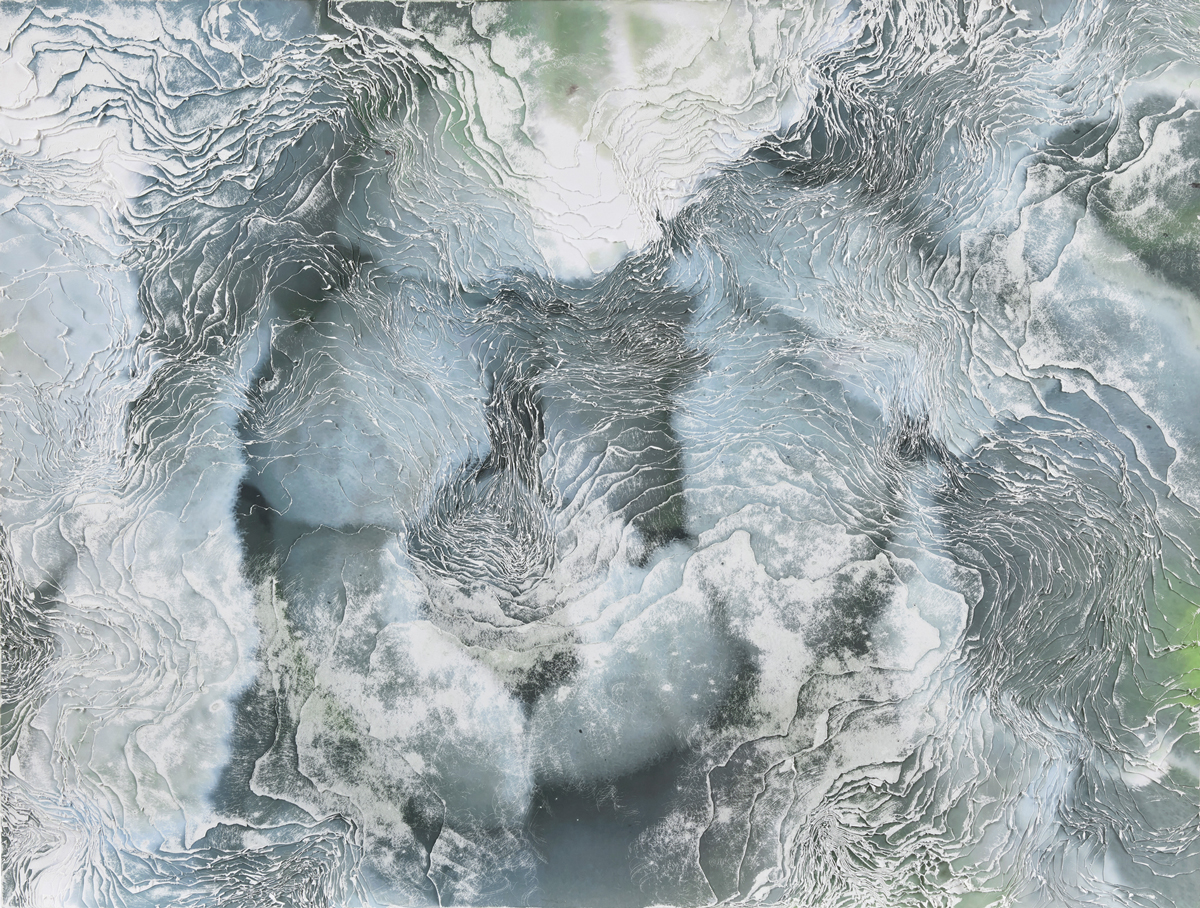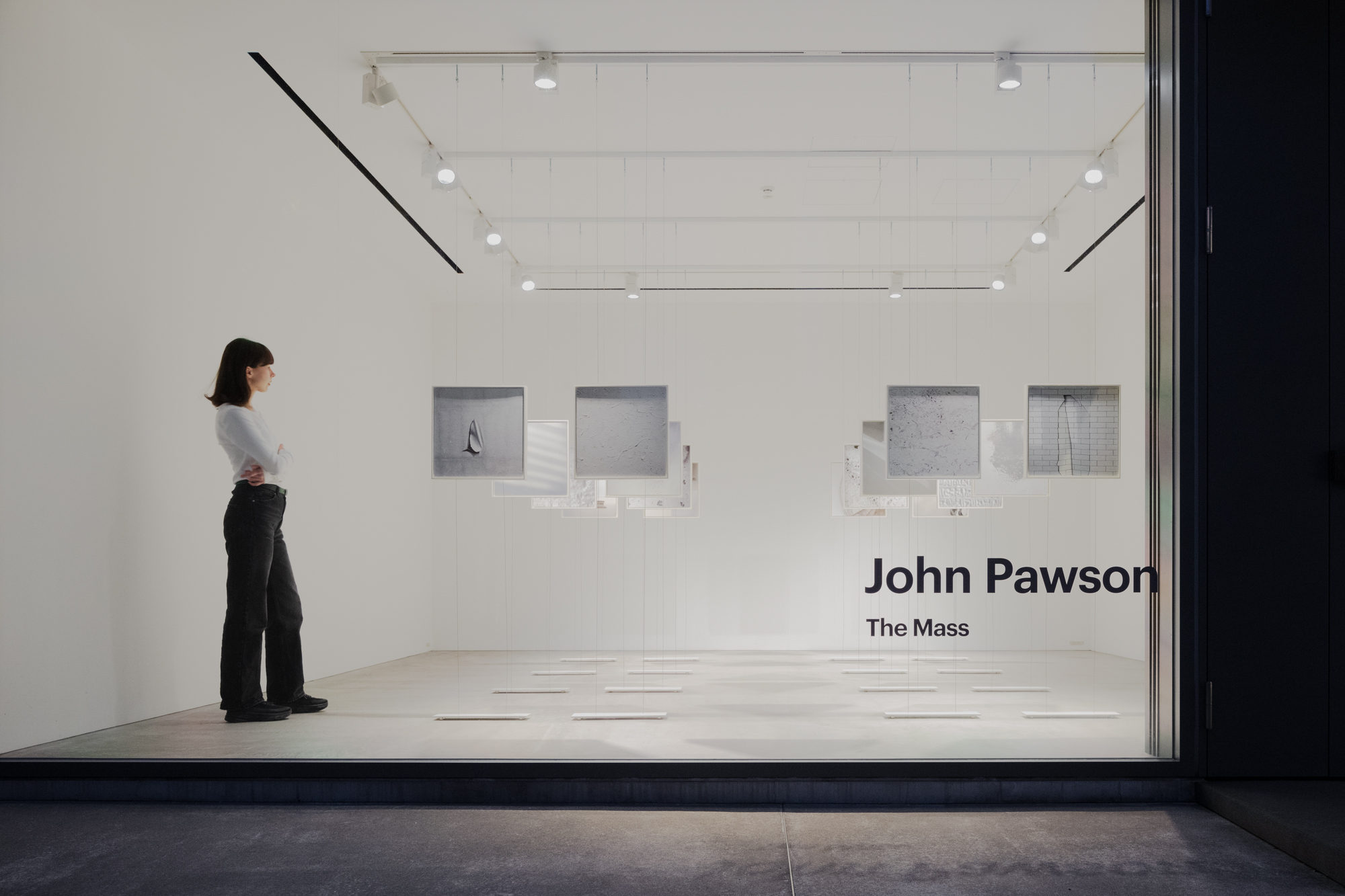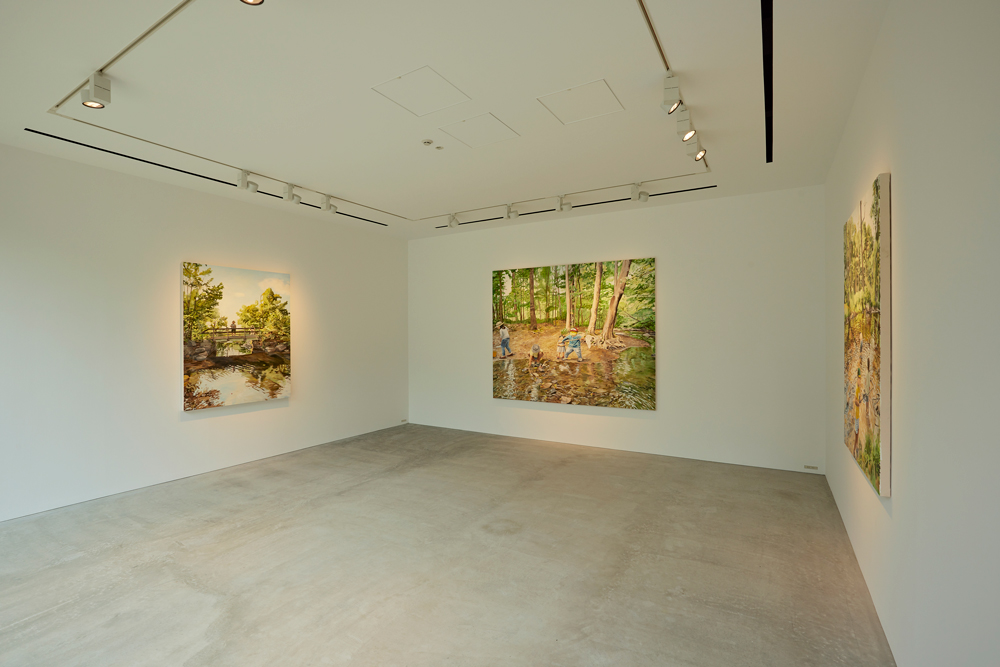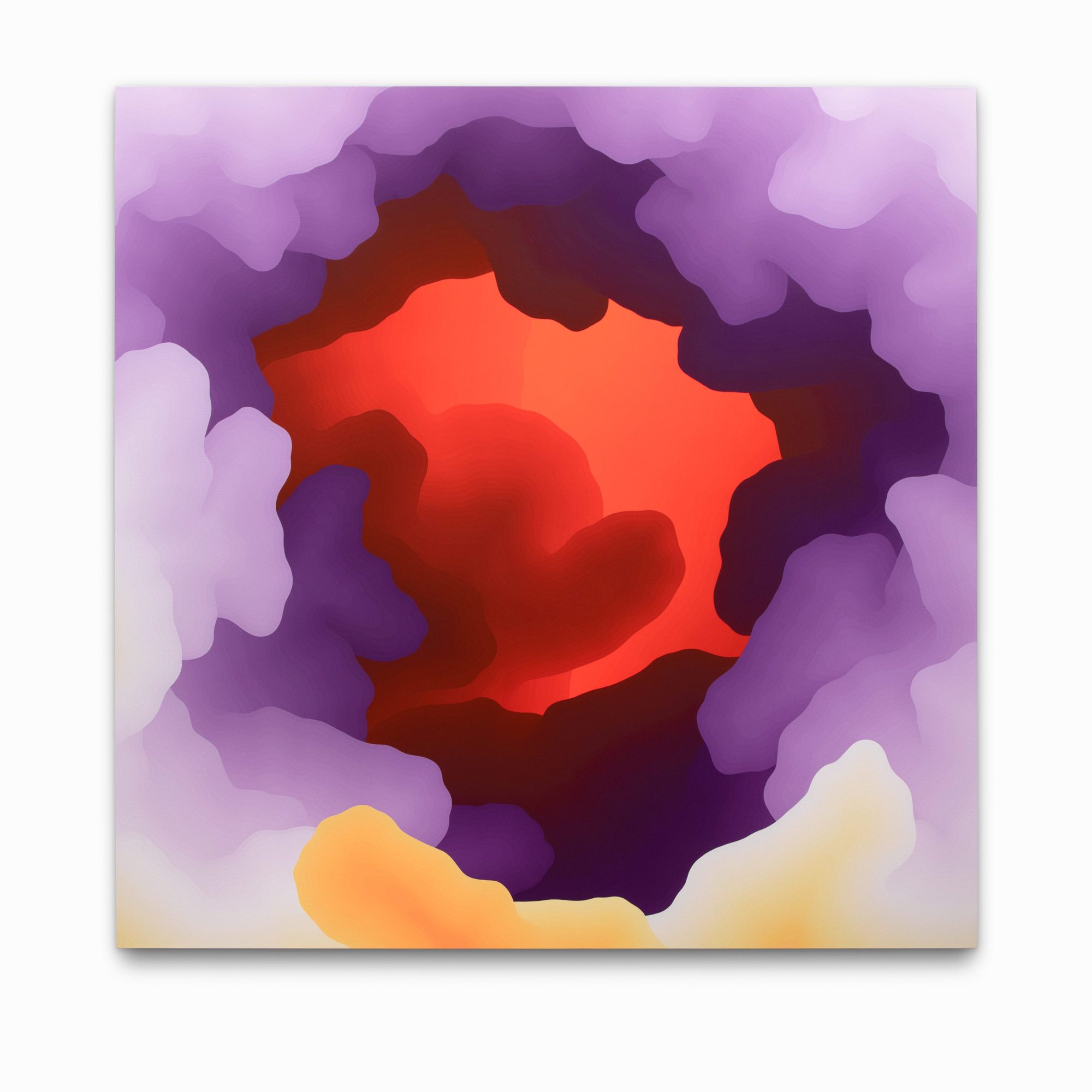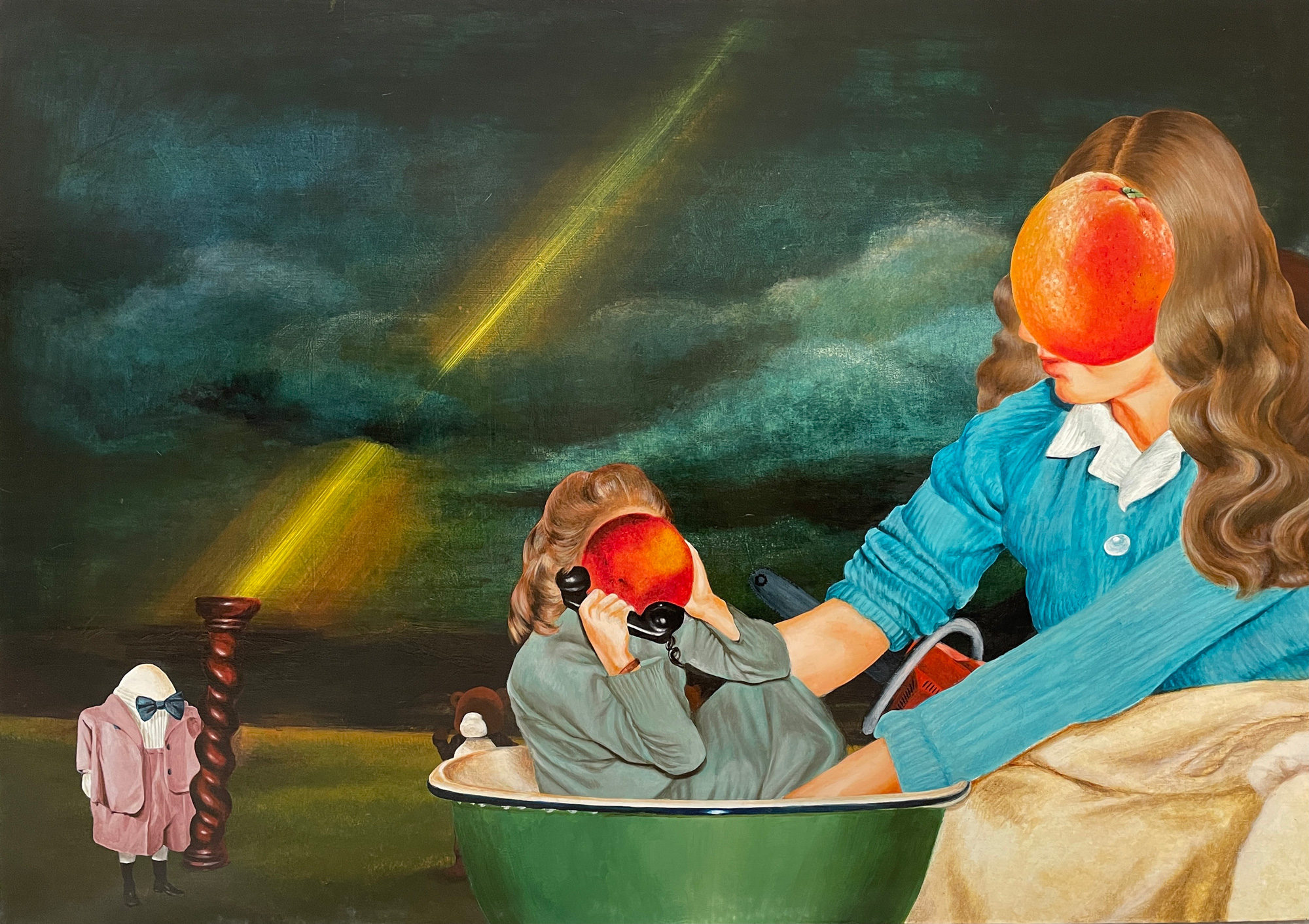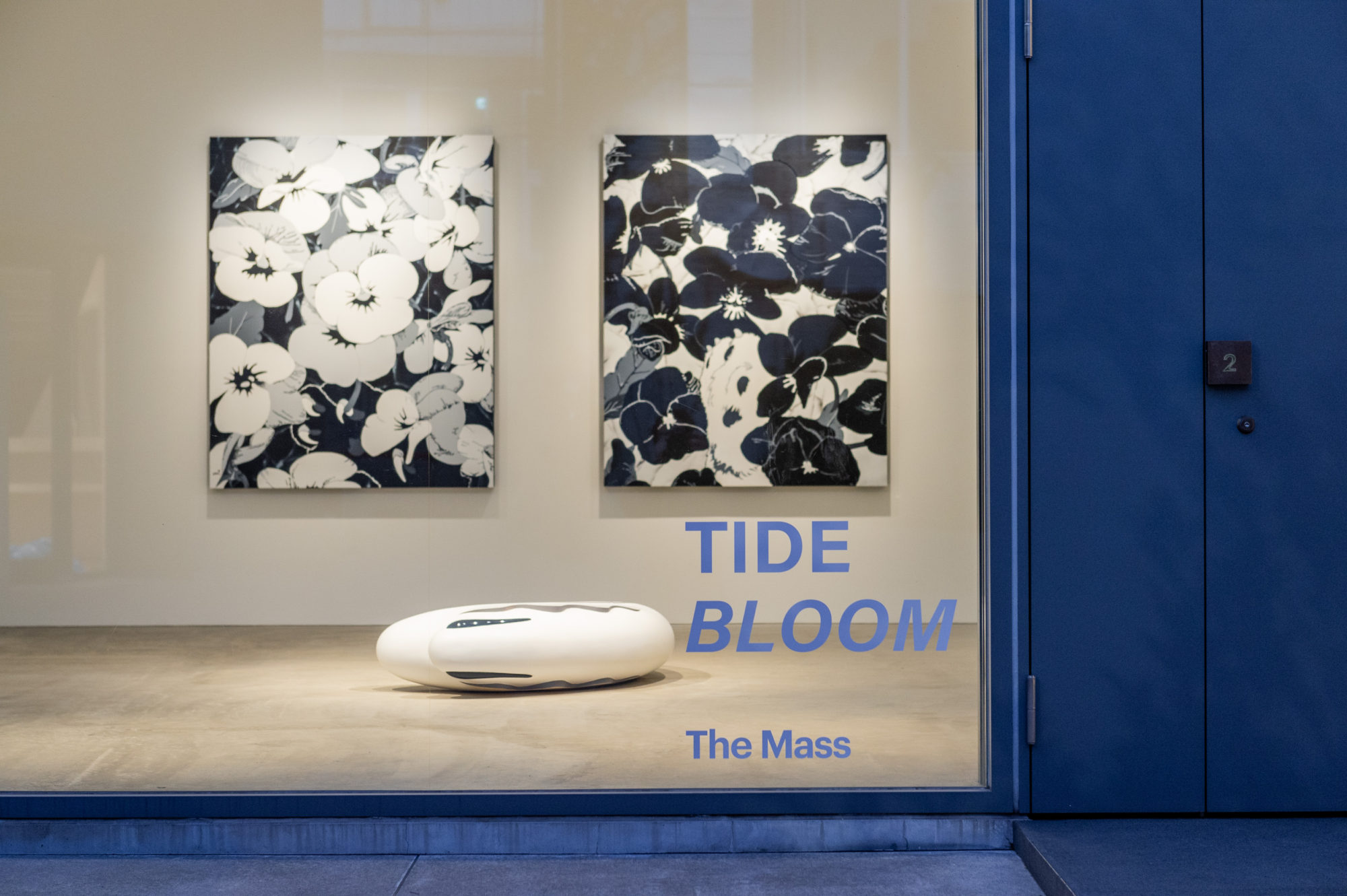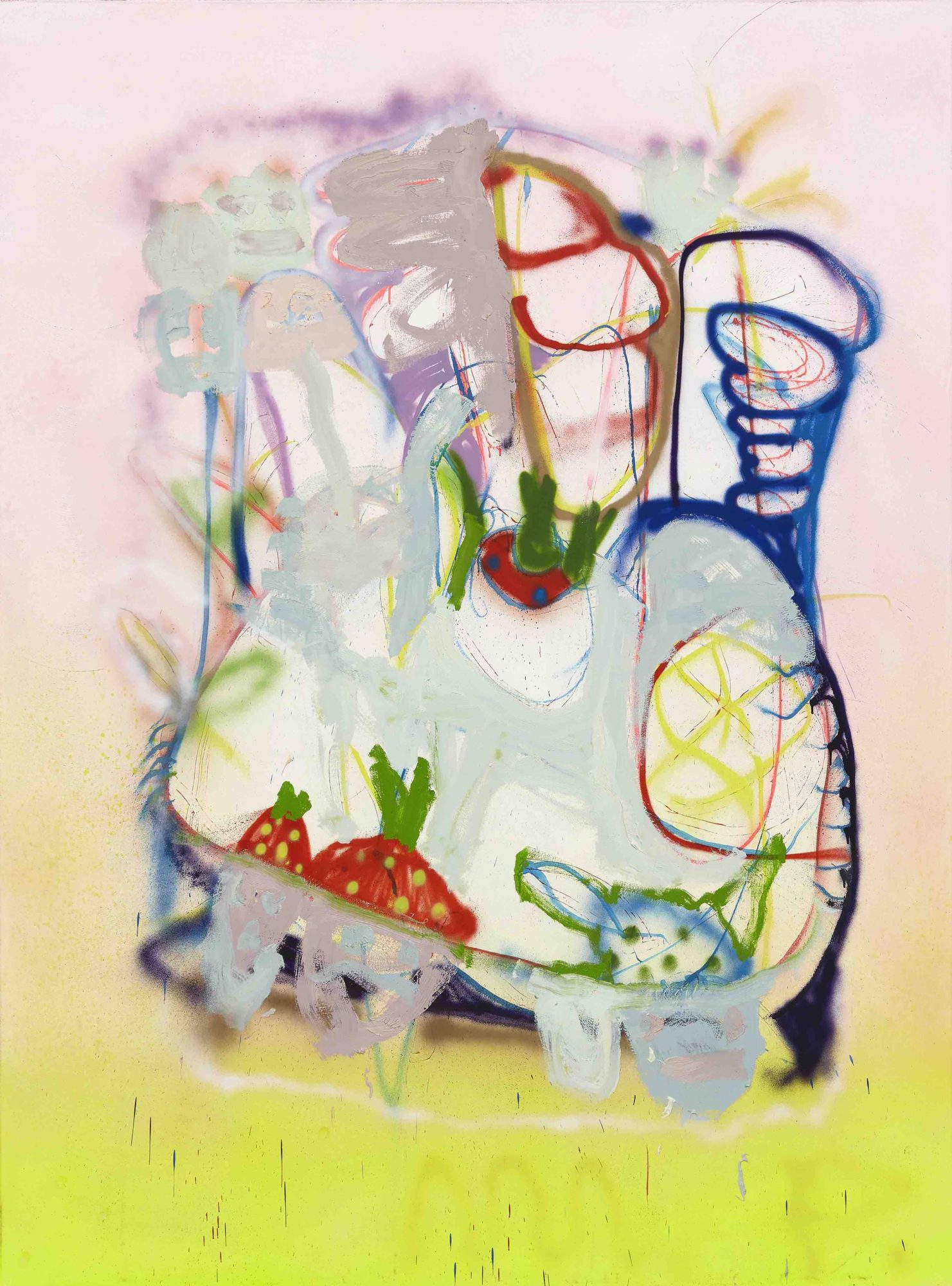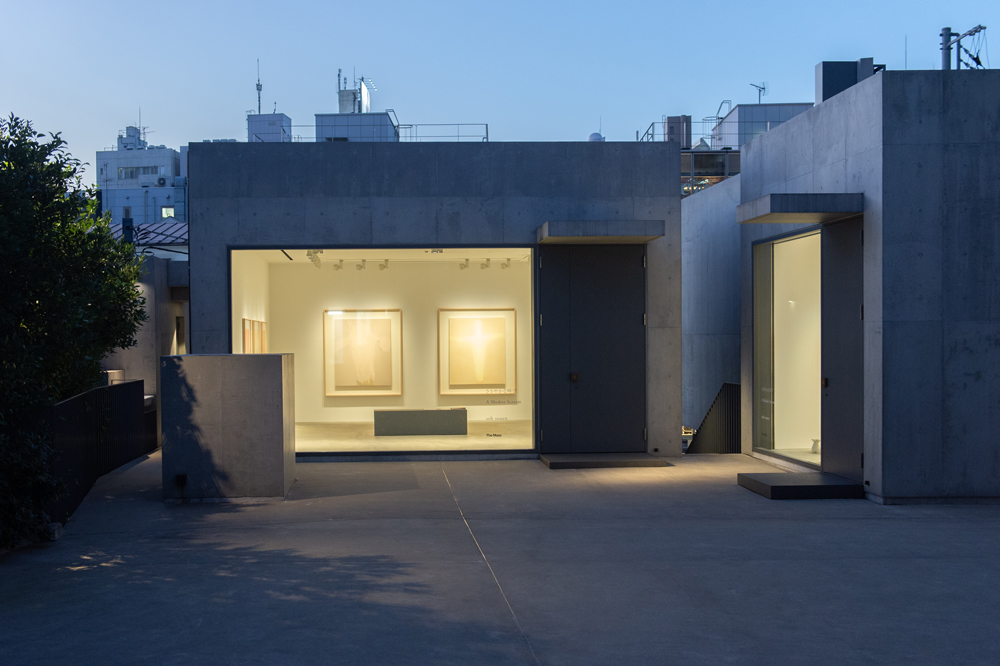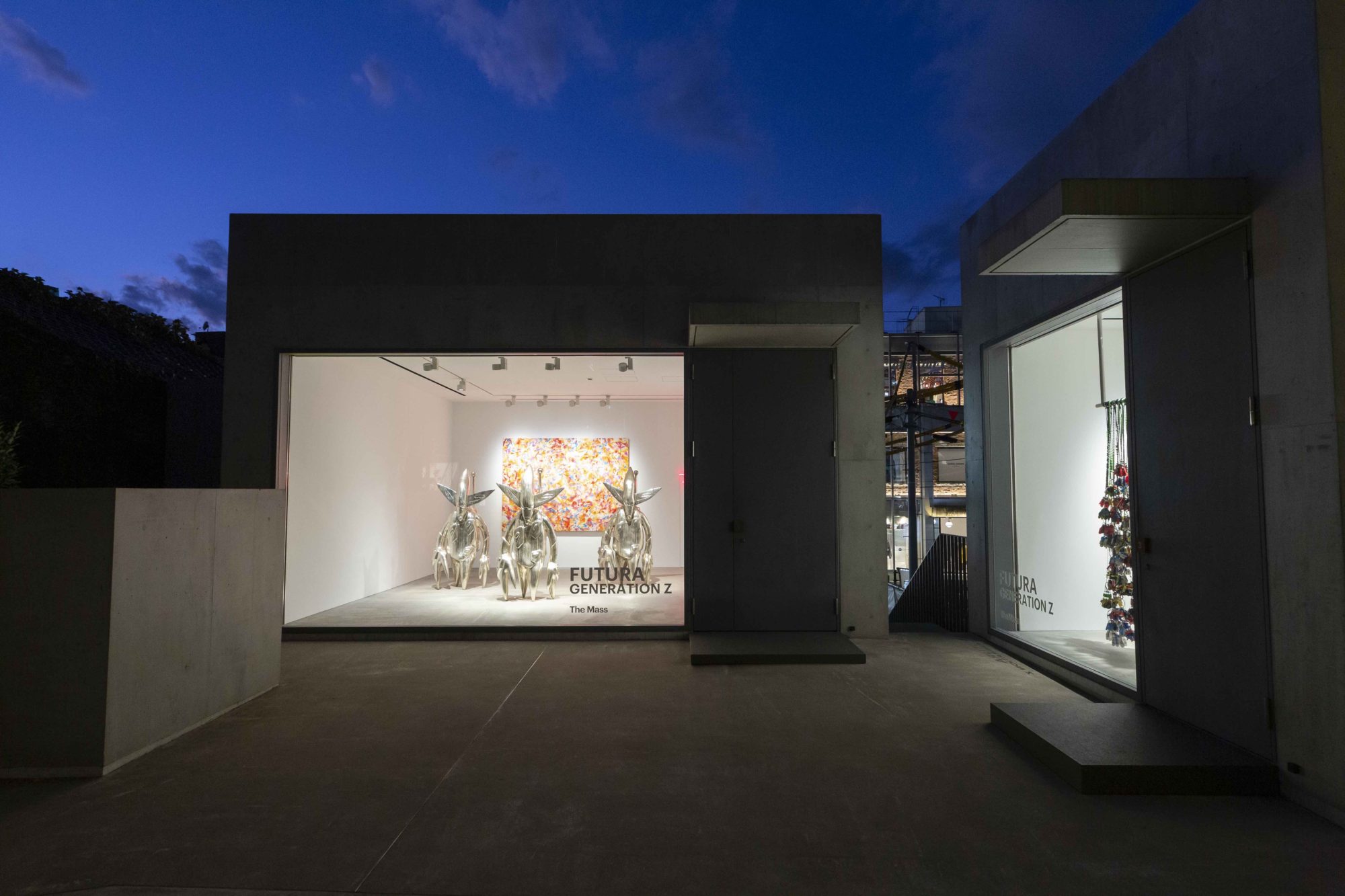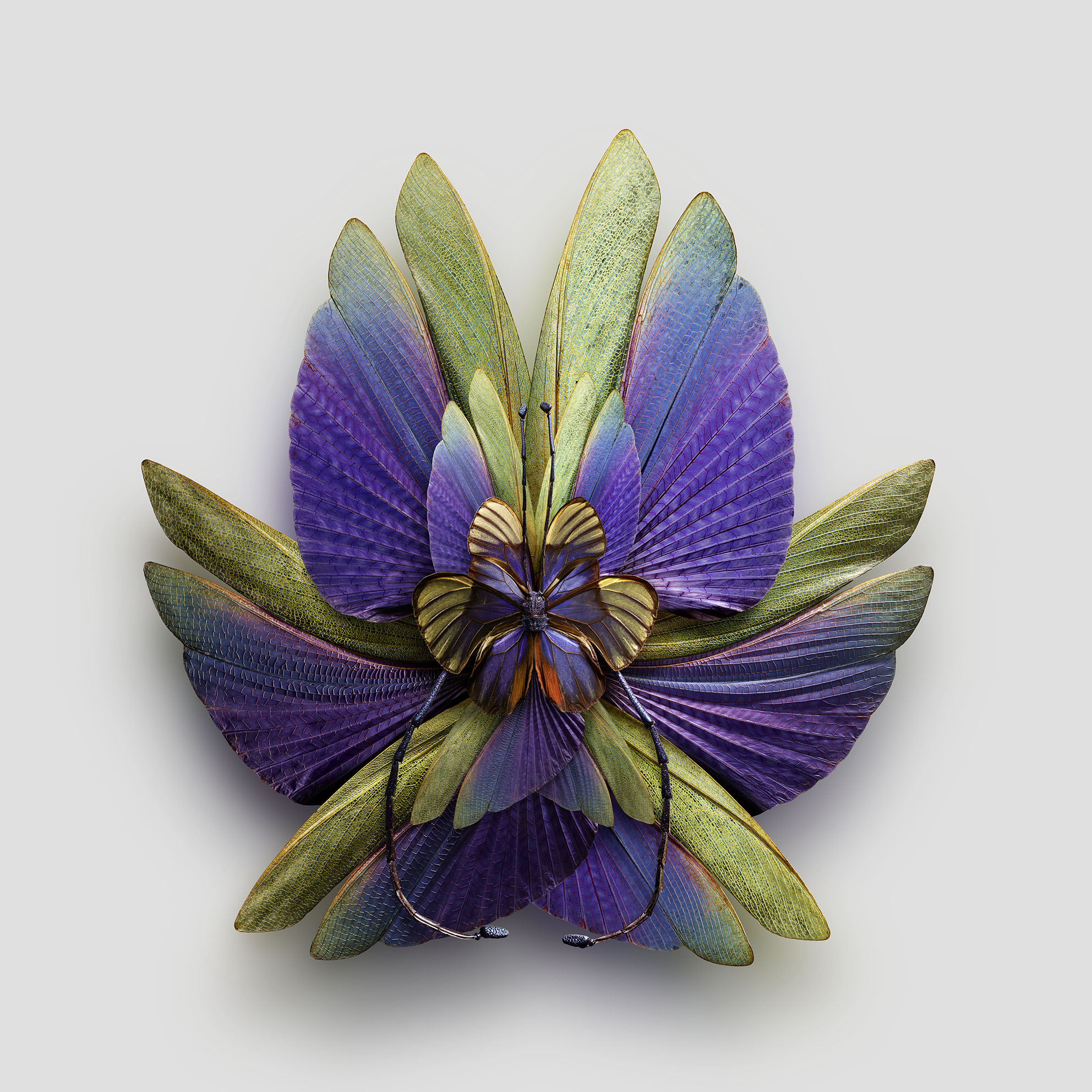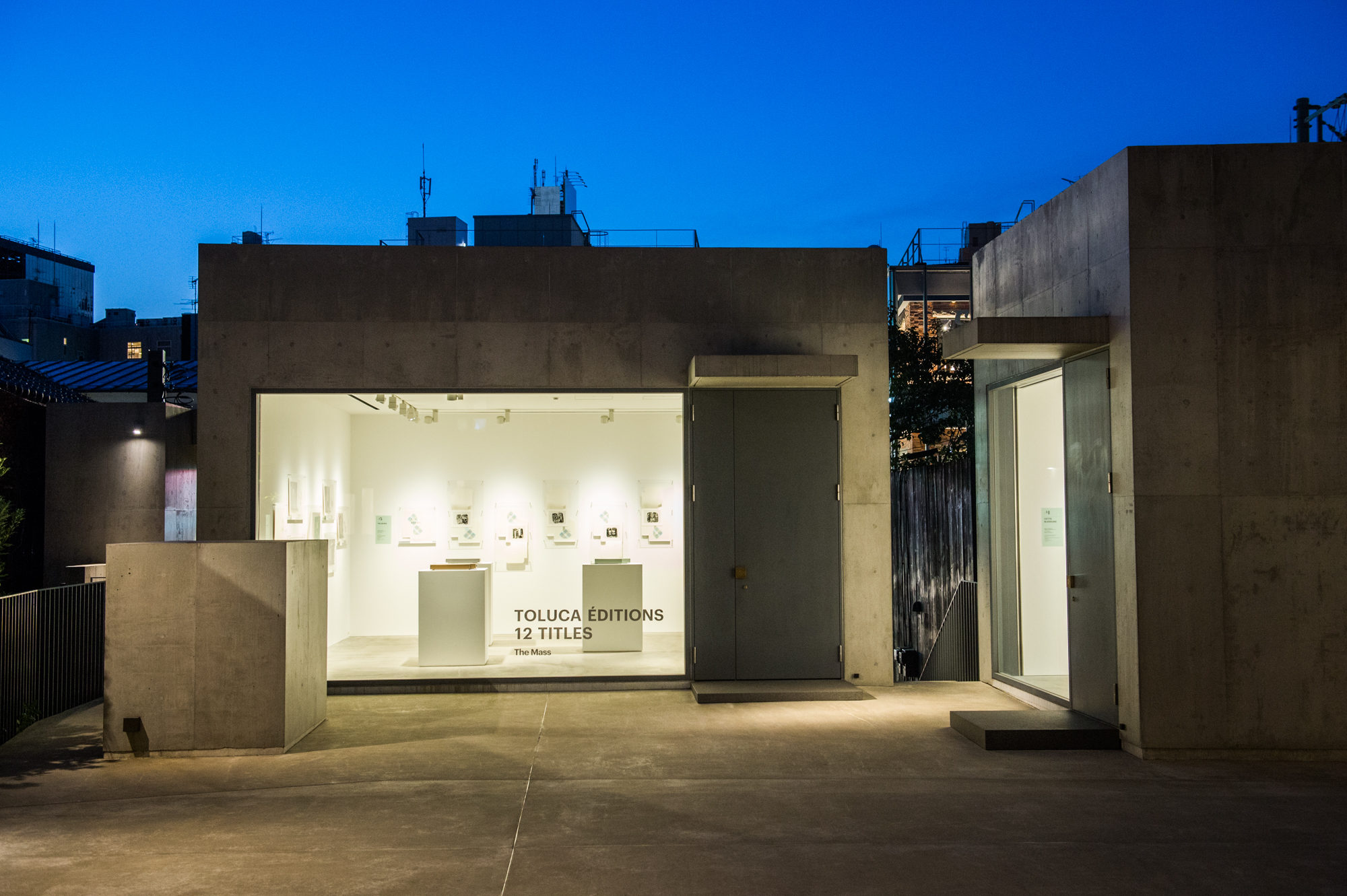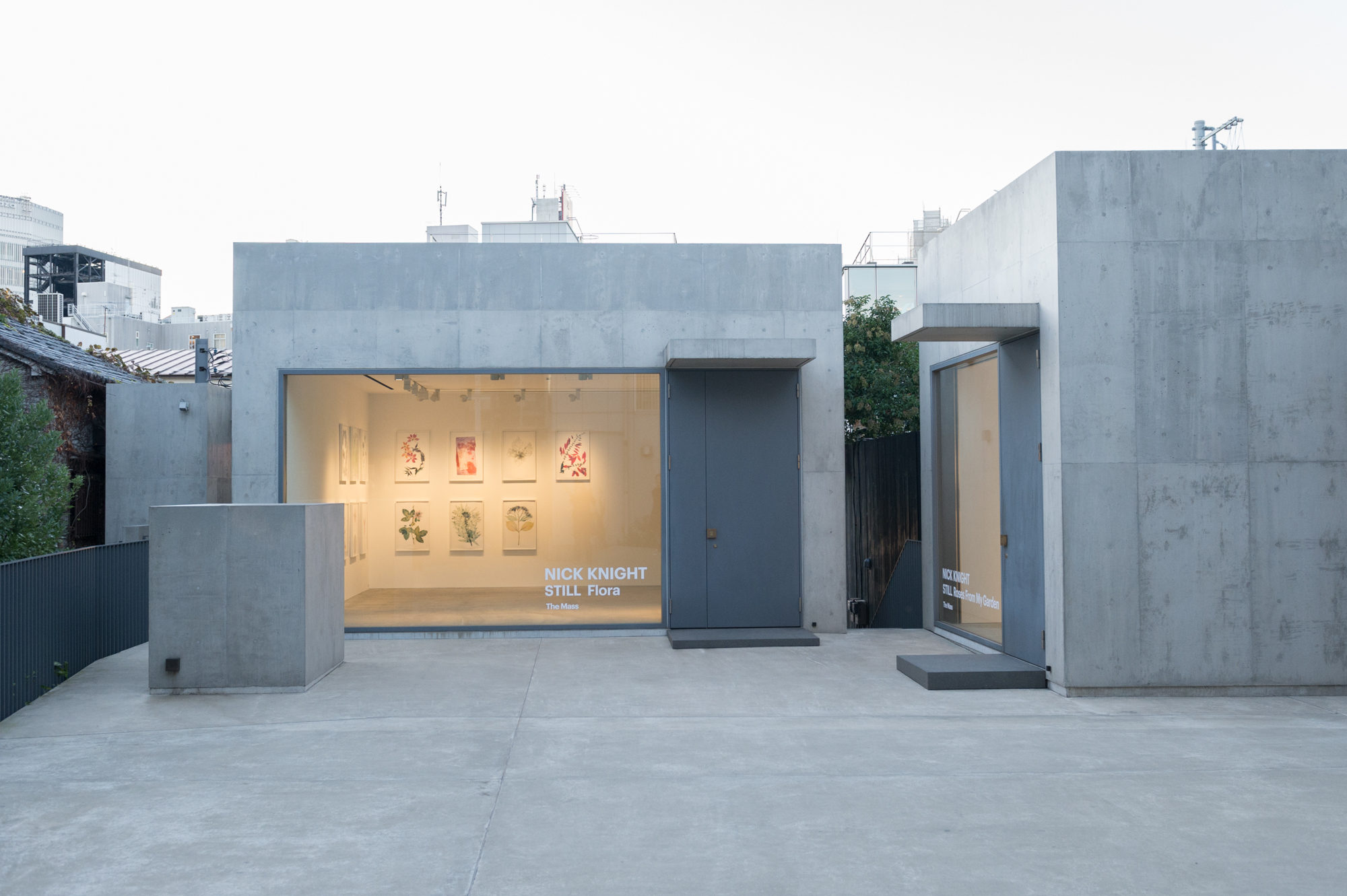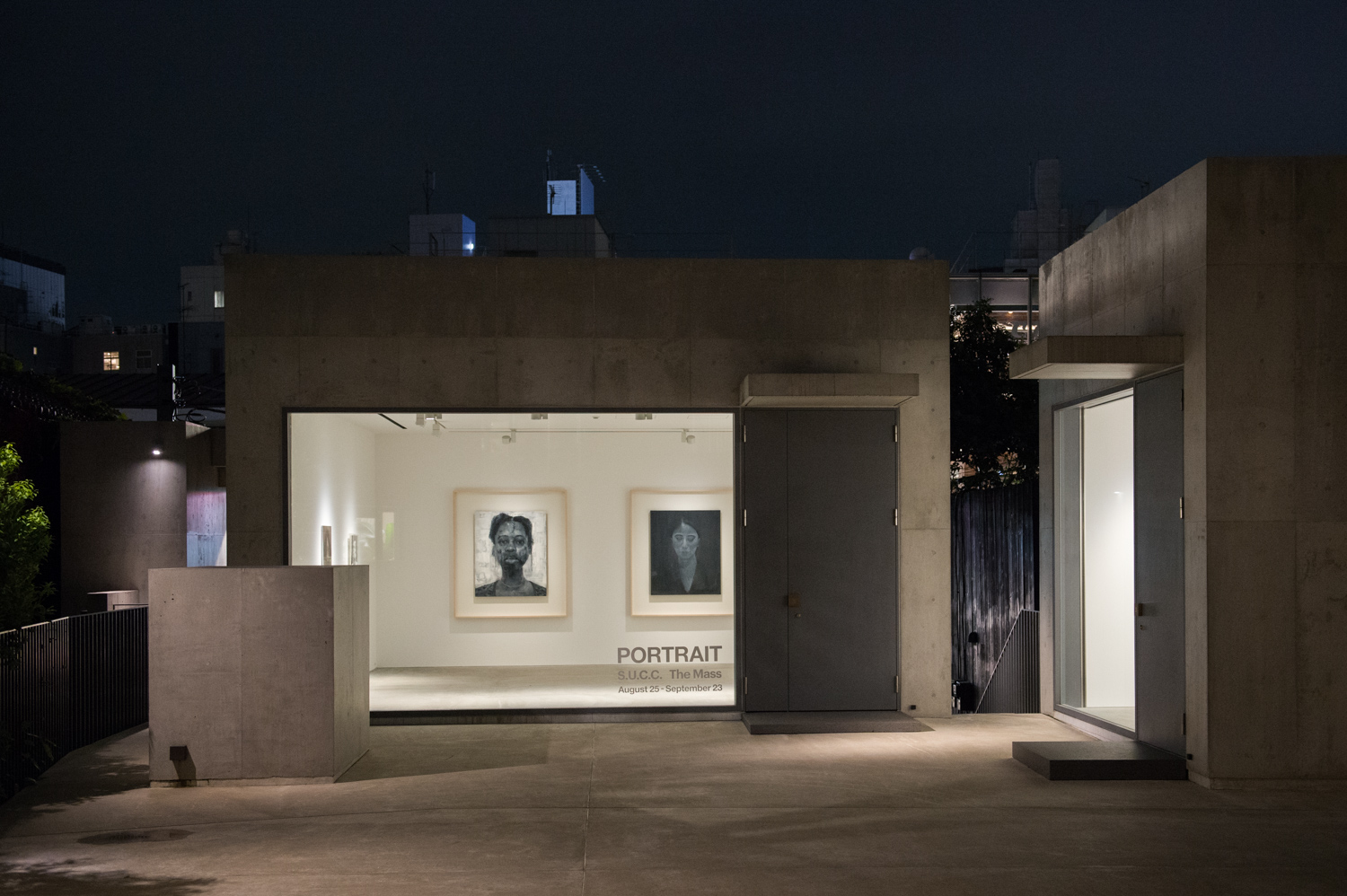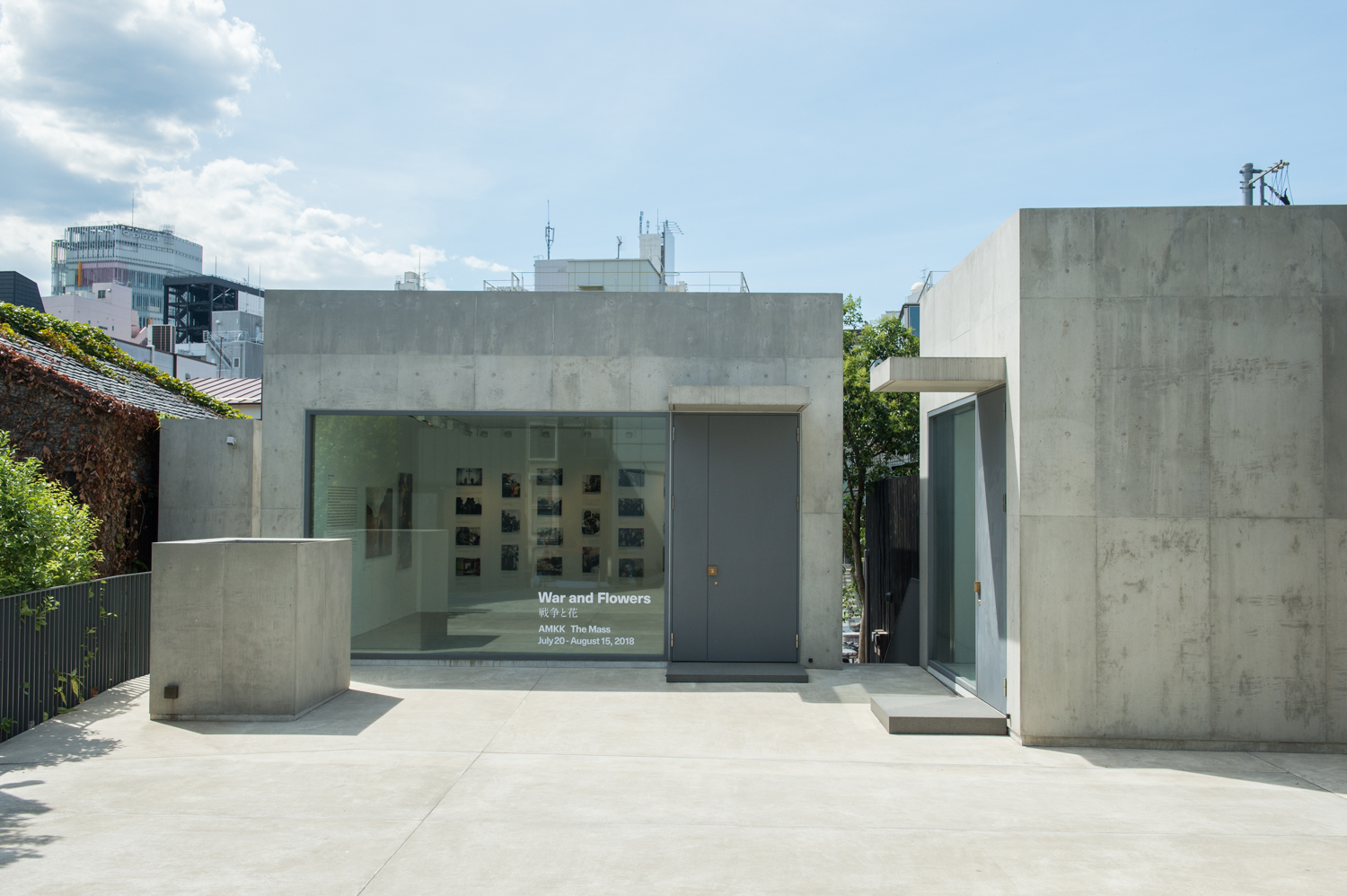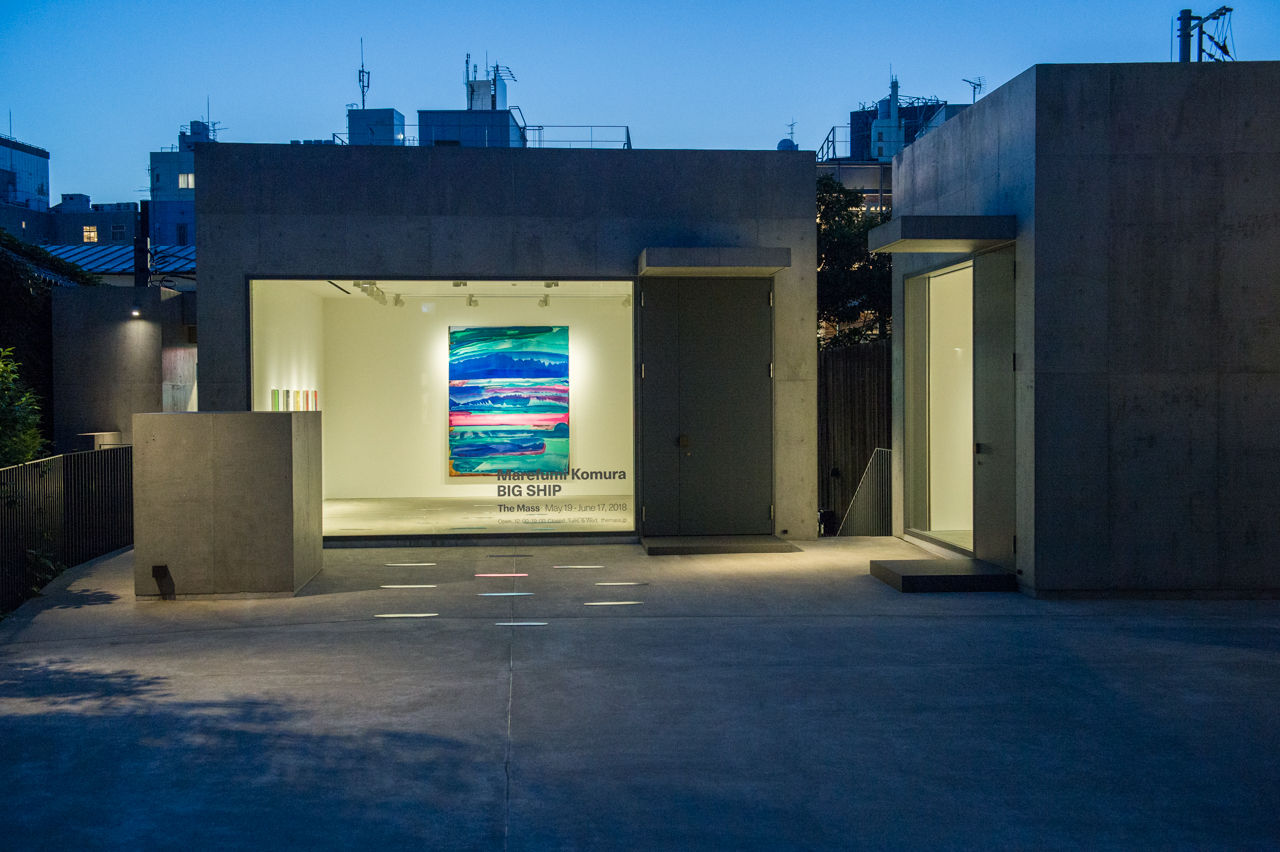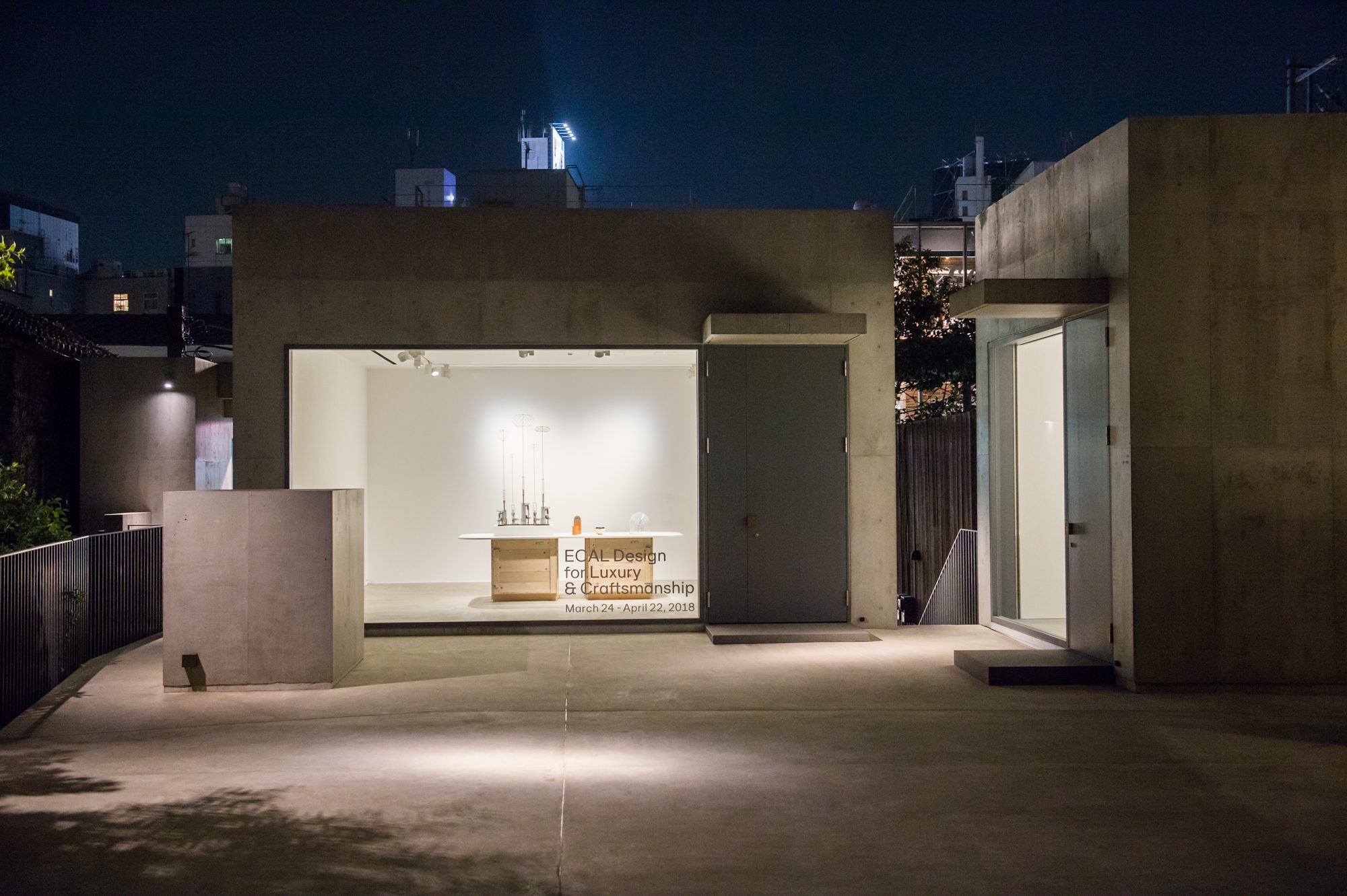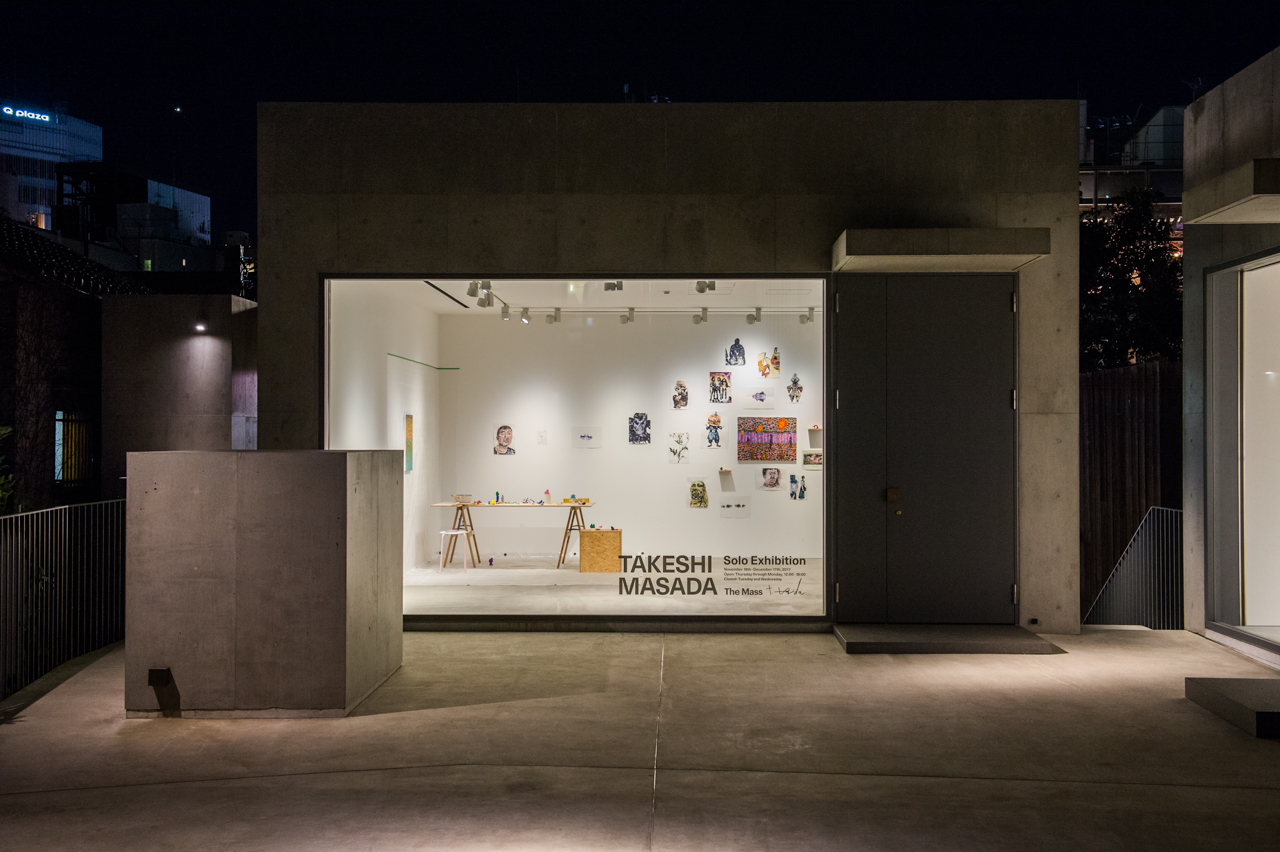PAST
Chromatic Studies
Lui Nemeth’s work deeply rooted in the fundamental process of creation itself. There is a deliberate rejection of physical form and object in her
work, seeking what is deeply internal and nearly inexpressible, evading clear representation. Nemeth’s generative approach in relation to artistic
form is centred on a sense of intuition and rhythmic improvisation, allowing each colour and brush stroke to emerge in their essential beings
through formal interplay, unified in compositional harmony through stitches of charcoal and pastel.
This current exhibition “Chromatic Studies” continues and builds upon ideas previously explored, capturing an emotional landscape across
different mediums and surfaces. For Nemeth, painting is a way to investigate existence as an emotional reality; similar to music, colour
communicates intuitively, without the need for viewers to search for any form of specific meaning. She relates to the music-making process,
finding resonance in spontaneous layering, harmonised through movement, which emulates the complexity of life. Each colour possesses its
own emotion, and together they create a rich, multi-layered expression that embodies the beauty of existence, in its simplest form.
Central to Nemeth’s work is the continuous study of energy, whether through sensitive duality in the perception of sound and colour, essential
distillation of being into textural movement, or even memorial qualities, which steadily inform the the various shapes of her art. Throughout her
work, there is a consistent focus on the artistic act itself – on the generative process of expression, where spontaneity and continuous change
are fundamentally valued. Finding purpose in the general unfolding of the creative process, Nemeth’s work proposes itself as a continuous
inquiry rather than a finished statement, maintaining itself in a state of perpetual motion through the movement which animates it.
Time Of Our Lives
The Mass is pleased to announce ‘Time of Our Lives,’ a group exhibition featuring 27 international contemporary artists curated by Easy Otabor of Chicago’s Anthony Gallery. An opening reception will be held on September 27, Friday from 6-8 PM.
Exhibiting artists include: Alvin Armstrong, Matthew Burgess, Ryan Travis Christian, Ryota Daimon, Liza Eilers, Sharif Farrag, Daniel Fleur, Bryant Giles, Takehisa Goto, En Iwamura, February James, Sydnie Jimenez, David Leggett, Brendan Lynch, Satoshi Miyashita, Okey Ofomata, Andrew Park, Jacob Rochester, Esperanza Rosas, Bryan Ruiz, Mia Scarpa, Natsuki Shibata, Kalan Strauss, Henry Swanson, Michael C. Thorpe, Eri Wakiyama, and Elizabeth Warfel.
Bringing together a diverse selection of international and Japanese artists, this exhibition creates a cultural crossover that fosters a dynamic global dialogue and celebrates identity, culture, and cross-disciplinary exchange. For many of the international artists, ‘Time of Our Lives’ marks their debut exhibition in Japan–offering audiences a rare opportunity to engage with some of the most promising emerging talents from the U.S. Spanning painting, drawing, and ceramics, the works on display offer progressive and innovative takes on traditional mediums. By weaving in imagery from pop culture and the internet, the artists capture the essence of contemporary life, while embracing a wide range of material and conceptual approaches.
Located in the Harajuku neighborhood, this exhibition serves as a community touchpoint for cultural exchange, sparking new conversations across artistic disciplines from Chicago, Japan, and beyond. The diversity and international approach of ‘Time of Our Lives’ reflects Tokyo’s dynamic arts scene, where tradition and contemporary innovation collide. “Tokyo has always been a dream of mine,” Easy Otabor states. “The energy in this city, specifically in Harajuku and Shibuya, is a vital source of inspiration for me. I’m honored to introduce the gallery’s dynamic program of contemporary artists to Japan.”
This collaboration between The Mass and Anthony Gallery not only pays tribute to Anthony Gallery’s Chicago origins but also establishes both galleries as international leaders in contemporary art, paving the way for future artistic exchanges on a global scale.
PREVIEW DOWNLOAD
Needles and Pins
The Mass presents, ‘Needles and Pins’, a group exhibition curated by the New York based artist Hiroya Kurata, featuring the work of 20 international artists from New York, Los Angeles, Seoul and Copenhagen.
The artists whose works will be featured in the exhibition are as follows: Margot Bird, Lola Gil, Jordin Isip, Rich Jacobs, Aaron Johnson, Misaki Kawai, Hiroya Kurata, Matt Leines, Raymond Lemstra, Gosha Levochkin, Dan Mandelbaum, Anthony Miler, Matt Phillips, Hunter Potter, Mason Saltarrelli, Koichi Sato, Eric Shaw, James Ulmer, Mark Whalen, and Eric White.
This exhibition provides a rare opportunity to show a mostly international group of artists, many of whom will be familiar to a Japanese audience, alongside artists who have never exhibited in Japan before. Artists such as Koichi Sato, Rich Jacobs, Misaki Kawai, Anthony Miler, Hiroya Kurata, Mark Whalen, Aaron Johnson, Margot Bird, Raymond Lemstra, James Ulmer and Matt Leines have exhibited in Japan on numerous occasions and are familiar faces in the contemporary art scene of Tokyo. They have also often exhibited their work within the context of the Harajuku and Shibuya areas, tying their respective communities on opposite sides of the globe with ours. The exhibition will also introduce a number of internationally recognised artists such as Lola Gil, Hunter Potter, Eric White, Jordin Isip, Matt Phillips, Mason Saltarrelli, Eric Shaw, Dan Mandelbaum and Gosha Levochkin, who having made a name for themselves in the US and Europe, will be showing their works in Tokyo for the very first time. The city of Tokyo has always been a place of interest for international artists and creators, and this exhibition stemmed from the pure and simple desire to show their works in Tokyo, in and amongst their peers:
‘Over the past few years, I have often talked with my friend and fellow artist Koichi Sato, about how it would be fun to have an exhibition in Tokyo with all of our artist friends. When I asked the friends I happened to see that week if they would be interested, they all replied enthusiastically.’
– Hiroya Kurata
Each of the artists within this exhibition have uniquely individual artistic approaches and styles that explore a vast range of themes and concepts. Though there are a number of corresponding ideas and techniques in which to make various groupings of artists, this exhibition does not attempt to establish an overarching theme or unifying concept – an almost impossible task amongst a group show with so many artists. Instead, this exhibition is an exploration of community and how the various intertwining locations and contexts in which each artist lives and works has formed a network of unique bonds and connections. This exhibition therefore aims to show a small section of the artistic community in a different part of the world, predominantly the city of New York, and recognise the real-life relationships that tie each of these artists together. The interlacing connections and relationships between the individuals in this exhibition take on various forms; from close personal friends, to friends of friends, mentors and mentees, and student-teacher relationships – as well as the distinct bond that is formed from sharing and exhibiting at the same galleries. This exhibition is therefore a representation of the organic and interconnected web of various figures that make up a section of the international contemporary art community, many of whom live and work in the same city, or are of a similar generation, and the shared or parallel contexts that help shape it. The majority of the artists in this exhibition are based in New York, and live and work in the Brooklyn and Queens area of the city, sometimes even sharing the same block of studios. For those not residing in New York, they either used to live there and have relocated to LA or Massachusetts, or have close connections to the artists based there, spreading the extended community as far afield as Korea and Denmark. This proximity, both in terms of geographical distance and social affinity, has helped to foster this sense of community, building connections and bridges that traverse notions of nationality or identity.
For Kurata, and many of the other Japanese artists now living abroad, this exhibition is an opportunity to share in the joy of exhibiting in and amongst friends in Tokyo, a place that was once home, thereby uniting these two communities. It also provides a chance for Kurata to reflect on the role of an artist, and recognise how each individual in this exhibition has chosen the life of an artist; a career path that is oftentimes unclear and uncertain, and acknowledge the mutual desire and need to create artworks that unites them. The title of the exhibition ‘Needles and Pins’ is a reference to the English idiom usually written in the reverse order; ‘Pins and Needles’. This phrase describes the tingling or numb sensation that occurs in extremities when the blood supply is cut off to the nerves. The phrase can also refer to the emotional state of ‘waiting for something to happen with anticipation and anxiety.’ Depending on the situation, this tingling sensation can be both positive and negative, and is a reflection of the artist’s constant state of existence in the unknown, something that undoubtedly many artists experience at some point within their careers. What unites these twenty individual artists is the collective necessity to create and show their artworks to the world. Over the years, there have no doubt been ups and downs, but the drive to continue working and pursue a life as an artist and be a part of their unique community is something to be celebrated and shared.
‘I don’t know the details of everyone’s situation, but I think most of them are or have been working other jobs in addition to their own. Some may have worked as art transporters, art teachers, assistants to other artists or in other non-art related jobs during the day. There are some people who also work solely as an artist, but whatever their situation, once they are hooked on the art-making bug, it is an addiction that they cannot quit. In other words, people who have been making art for many years are the ones who couldn’t stop making art, even if they wanted to. There are years when things go well and years when things don’t go so well, and as with any genre, there is no such thing as stability. I often liken artists to children who are entirely immersed in their work, but forced to sell them in order to make a living. To sell your works, in a sense, you have to be recognised by others. This is where you leave your own small world and enter the world of harsh criticism. Oftentimes you are overlooked, or told that you are misguided, but sometimes you are given praise. As you repeat this process, you continue to make your works with both anticipation and anxiety. From this perspective, I thought the title “Needles and Pins” was the perfect encapsulation of this feeling.’
Hiroya Kurata, Artist and exhibition curator
Eric White, Collusion: Deborah, Oil on Panel, 406 x 406 mm, 2018 Courtesy of Artist, The Mass and GRIMM,
Amsterdam | London | New York
PREVIEW DOWNLOAD
REVERBERATION
【Nerhol Exhibition Extended】
The Mass is pleased to announce that the dates of our current exhibition, ‘REVERBERATION’ by Nerhol, have been extended into the new year.
The exhibition will re-open from Saturday 6th January to Sunday 21st January 2024 to coincide with the public production of Nerhol’s installation artwork at StandBy.
*Please note that the gallery will also be open on Monday 25th December and Tuesday 26th December 2023, our last opening dates in 2023 before we close for the holidays.
We look forward to your visit.
The Mass presents, ‘REVERBERATION,’ an exhibition of new works by the artist duo Nerhol.
In this exhibition, the duo will present new works centred around the theme of naturalised plants, a subject matter which they have been consistently working on in recent years.
Nerhol consists of Ryuta Iida and Yoshihisa Tanaka, and their work is a fusion of their respective crafts; Iida, who carves and sculpts, and Tanaka, who works with paper and two-dimensional compositions. In their practice, the pair physically build up a series of photographs of a particular motif and sculpt them into a single piece. The resulting work speaks to the multilayered moments of time contained within it. Their attempts to work against the layers of time and history contained in the photographs have resulted in works of art that take on new physical forms and visual aesthetics that are entirely unique.
The naturalised plants that form the theme of Nerhol’s work in this exhibition are plants that have been transported from their original native habitat to other regions due to various factors, including human activities, and have eventually become wild in these new areas. Contained within these plants is an existing history, something that transported them, or the human actions that created the cause and effect. It is these intrinsic concepts of time and history and the intervention and intertwining of various factors that are the underlying essential concepts of Nerhol’s work.
In all of Nerhol’s works, the accumulation of time has been replaced by layers of paper, and through the sculpting of them, reveals the “something” contained within. Iida’s physicality and Tanaka’s thoughtfulness accompany the work, and the density of it has been heightened by their repeated acts of ‘dialogue’ that the two of them repeatedly engage in. For the two artists, the act of ‘dialogue’ is already an intrinsic part of their practice, and is in fact, at the very heart of it.
The naturalised plants shown in this exhibition are part of an ongoing series that Nerhol has been working on for the past few years, and is a body of work that reminds us of the things we normally see without thinking, and provides us time to look again and reassess. Naturalised plants have historically survived on a completely different time scale from our own and are full of vitality and adaptability to their environment, proving they are both resilient and beautiful.
Both a photograph and a sculpture.
Both a moment and a history.
Nerhol’s work exists at the intersection of these elements and is full of questions and challenges, dealing with universal themes while constantly seeking new forms of expression. It is an act of approaching the essence of art itself. Nerhol’s art is a form of dialogue that requires flexibility, diversity and understanding of others; an important act within today’s society.
NERHOL
Nerhol is an artist duo that consists of Ryuta Iida and Yoshihisa Tanaka.
The pair had previously developed their own independent practices, but found an affinity in their methodology for how to raise issues and communicate them to people in the present day, and in 2007 they began their activities as Nerhol. Their work began as an exploration of the differentiation of the canonical forms of the written word, its inscriptions and pre-existing iconography, and in 2011, Nerhol began to attract a great deal of attention with their sculptures of distorted human figures, created by sculpting a bundle of more than 200 different portraits taken in a just few minutes. Since then, they have participated in numerous exhibitions at galleries and museums in Japan and abroad, selecting various motifs such as roadside trees, animals, water, image data uploaded onto the internet and video records; creating works that distort the time axis of these various motifs. In their work, they consistently attempt to reveal the multi-layered modes of existence within organic objects that we tend to overlook in our daily lives.
Major solo exhibitions include ‘Affect’ (Daiichi Seimei Gallery / M5 Gallery, Tokyo, 2023), ‘critical plane’ (Yutaka Kikutake Gallery, Tokyo, 2021), ‘Interview Portrait House and ‘Room’ ( Youngeun Museum of Contemporary Art, South Korea, 2017), ‘Promenade’ (21st Century Museum of Contemporary Art, Kanazawa, Ishikawa, 2016), ‘Index’ (Foam Museum, Amsterdam, 2015). Group exhibitions include ‘The 8th Tsubakikai Tsubakikai 8 This New World / This New World 2nd SEASON “QUEST”‘ (Shiseido Gallery, Tokyo, 2021 / 2022), ‘New Photographic Objects: The Materiality of Photography and Video’ (Saitama Prefectural Museum of Modern Art, 2020), ‘VOCA Exhibition 2020: Prospects for Contemporary Art – New Flat Artists’ (Ueno Royal Museum, 2020), ‘Megururi Art Shizuoka; (Shizuoka City Museum of Art, 2017). Major awards include the VOCA Prize (2020).
Iida was born in 1981 in Shizuoka, Japan. In 2004, he graduated from the Department of Sculpture Course of the Fine Arts Department of Nihon University College of Art and completed his postgraduate studies in Advanced Art at Tokyo National University of Fine Arts and Music in 2014. He is currently based in Tokyo.
Tanaka was born 1980 in Shizuoka, Japan. In 2004, he graduated from the Department of Spatial Design, Musashino Art University and is currently undertaking a master’s degree at the Graduate School of Media and Governance, Keio University. He continues his activities based in Tokyo.
Special opening on Monday December 25th and Tuesday December 26th
©︎Nerhol, Courtesy of artist and The Mass
PREVIEW DOWNLOAD
John Pawson
Whilst still best known as an architect, in recent years John Pawson’s photographic work has been garnering growing international recognition. This trajectory of interest originated in the publication just over a decade ago of A Visual Inventory (Phaidon Press), followed five years later by Spectrum (Phaidon Press), which was transposed by curator Carrie Scott from the pages of a book into an immersive architectural installation in an iconic brutalist building — 180 Strand — in central London. In 2021 John Pawson – A Point of View was then mounted at the Casa Dei Tre Oci, during the Venice Art Biennale and in 2022 John Pawson, Looking for Light, comprising sixteen new print works, formed one of the inaugural exhibitions at the Bastian Gallery in Berlin.
This new exhibition at The Mass, Tokyo — the first solo exhibition of Pawson’s work in Japan — provides visitors with an intimate opportunity to experience Pawson’s unique perspective on the world — his point of view — as its focus shifts from tiny details of colour, texture and formal composition to evocations of light, atmosphere and emotion:
The exhibition programme is divided between the three gallery spaces of The Mass and an outdoor area in the neighbouring StandBy. Two galleries offer a visual encounter with sequences of chromatically ordered images drawn from Spectrum, while the third space debuts Pawson’s series Home, where the subject of the artist’s lens is his own domestic environments. Set in counterpoint to this photographic inventory is a contemplative installation, commissioned for The Mass and constructed in proximity to Harajuku’s Cat Street within the installation space, StandBy. Across more than four decades of practice, Pawson has been consistent in his view that his work is architecture not art, but with Lunula — titled Lunula for its crescent geometry — he consciously pushes closer to the very threshold of such distinctions, with the creation of a charged, inhabitable form in which space, surface, light and the burning of incense are experienced as a resonantly seamless totality.
The exhibition is a sort of homecoming for Pawson, who spent a number of years in his mid-twenties teaching English in Nagoya, before moving to Tokyo where he frequented the studio of renowned architect and designer Shiro Kuramata. His experiences in Japan and his encounter with Kuramata left a lasting impression on the young Pawson, leading to his multifaceted career that encompasses architecture, photography and design.
To coincide with the opening of the exhibition, The Mass will host an artist talk event between John Pawson and Japanese artist, Hiroshi Sugimoto. The talk will be moderated by the exhibition curator, Carrie Scott, and will provide an opportunity for the two figures to discuss each other’s life and work in a variety of fields. The event will take place on the evening of Friday April 14th and will be free and open to the public, with limited seats available by reservation. Further details on the talk, start time and how to make a reservation will be shared via The Mass’ website and social media.
John Pawson
John Pawson CBE, RDI, born in Halifax, Yorkshire in 1949
Following a period of employment in the family textile business, Pawson lived and worked in Japan for four years in his mid-twenties, before returning to London to study at the Architectural Association School of Architecture. He established his architectural practice in 1981, designing spaces with clean lines, oriented in precise details devoid of excess ornamentation. This minimalist aesthetic has lent itself to the design of homes, stores, hotels, monasteries, ballet sets and art galleries. Notable projects include the Design Museum in London, Bastian Gallery in Berlin, the Abbey of Our Lady of Nový Dvůr in the Czech Republic, the Calvin Klein Collections Store in New York and the Jil Sander flagship store on Omotesando.
John Pawson, Spectrum, 2019, Courtesy of the artist
Photograph: Keishin Horikoshi / SS
PREVIEW DOWNLOAD
Summer Hours
The Mass presents ‘Summer Hours’, a solo exhibition by Hiroya Kurata, taking place from August 27th to September 25th, 2022. The exhibition will be Kurata’s first exhibition in Japan for three years, presenting 18 new works on canvas.
Kurata’s paintings depict familiar scenes from everyday life, providing vignettes of fleeting moments permeated in pure light that capture “what can only be depicted now”, thereby communicating his inner feelings that cannot be expressed exclusively in words.
As the title of the exhibition “Summer Hours” suggests, the subject matter of Kurata’s paintings convey an atmospheric impression of the season, with landscapes bathed in bright and dazzling sunshine, dappled light streaming through the trees, frolicking children, reflections of the clear skies on the surface of water, and the light of a full moon softly illuminating the night sky. The figures in Kurata’s paintings are deliberately simplified, depicted in a free-form manner that is charmingly distorted, and with a sense of familiarity that invites us into the humorous world spread across his canvases.
After the global disruption of the COVID-19 pandemic, like many people, Kurata began to spend more time with his family and in nature and began to draw and create works based on his own photographs and experiences from his daily surroundings. At first glance, his often cartoon-like compositions and the richly coloured style of his works appear to be painted with watercolours or crayons. However, closer inspection reveals Kurata’s use of oil paint and through the careful strokes of his brush, he is able to project various scenes from his daily life in New York onto the canvas, as if he were keeping a diary.
For the past 23 years, Kurata has been living in New York and has been working in a painting restoration studio alongside his own practice since 2007, acquiring various painting techniques along his 15 year career in restoration. For Kurata, New York offers a convenient location in which to work, and his unique position has allowed him to be a member of the international community of artists and art world figures that reside there, as well as witness firsthand the changes in the American art scene. Kurata’s free and individual style is evidence of his flexible approach to painting, unrestricted by a fixed concept or context, thereby giving him the freedom to paint the subjects that he wants to paint. Though his painting style has changed significantly over the past few years, there is a consistency in his power of observation and the unique interpretation of his surroundings, as well as an innate charm and rich sensibility that lies in opposition to mass media and popular culture, creating a continuous thread throughout his work.
Hiroya Kurata
Born in 1980 in Osaka, Kurata graduated from Parsons School of Design in 2003 and has been based in New York for the past 23 years. Recent exhibitions include solo shows at Ross + Kramer Gallery (New York, 2018), Monya Rowe Gallery (New York, 2019), Over The Influence (Hong Kong, 2021), and SPRING/BREAK Art Show ( (New York, 2019). In Japan, he has participated in a two-person show with Koichi Sato at Destroy Your Habits (Tokyo, 2021) and a group show at PARCEL (Tokyo, 2021). This will be his first solo exhibition in 3 years since his solo exhibition at KOKI ARTS (Tokyo, 2019).
Image: Close Encounter, 2022, Oil on Canvas, 183 x 147.8 x 4cm
PREVIEW DOWNLOAD
Room Service
The Mass presents Room Service, a solo exhibition by Sam Friedman, curated and produced in collaboration with the Detroit-based gallery, Library Street Collective, and US-based creative agency and artist management firm, ICNCLST. The exhibition marks the artist’s first solo exhibition in Japan and will present all new canvas works from his ongoing ‘Cave Paintings’ series.
With their flowing lines and subtle colour gradations, Friedman’s works are a harmony of abstract forms that ripple across the surface of the canvas. Taking a formalist approach to painting, Friedman’s canvases are an exercise in abstraction that echo organic elements and textures found in nature. Finding inspiration in the natural landscape of his surroundings in upstate New York, his paintings are an attempt to put the images in his mind to canvas, whilst constantly adapting and changing his approach as the work unfolds. Often working on numerous canvases simultaneously, he creates iterations and sequences of works that share similar ideas, with each work becoming a unique manifestation of a concept that he can return to and examine in perpetuity.
Much like his painting process, Friedman resists concept of time and linear narratives. The seeds of his ‘Cave Paintings’ series began to emerge in his earlier representational landscape works, continuing and flowing through abstraction and repetition. With each subsequent exhibition, the series fluidly evolves and shows the subtle shifts in Friedman’s process. Due to the continuous nature of his practice, these changes move back and forth between abstraction and representation in a cyclical manner that is both methodical and repetitive, yet unrestricted and spontaneous. Speaking of this process, Friedman stated that his works start at a point from which he builds and adjusts as the idea grows, but oftentimes ‘the painting takes control [and] becomes its own boss.’ For Friedman it is the acceptance of this process and allowing the work to find its own direction that enables him to create images full of intrigue and limitless possibilities.
Friedman’s works follow in the tradition of American Abstract Expressionist painters such as Clyfford Still and Barnett Newman, however, his points of reference are far more wide-reaching, looking also towards representational artists, landscapes and Japanese woodblock prints. Closer inspection of Friedman’s works reveal that the colour gradations are formed from demarcated lines that seamlessly shift into one another. The lines and forms of the painted surface are reminiscent of the contour lines on a map, or the rippling raked lines of a ‘karesansui’ (Japanese Zen garden), both stylised representations of nature that have been unified into a graphic delineation. Indeed there are certain parallels between ‘karesansui’ and Friedman’s paintings as both, in effect, capture the essence of the natural landscape around them and create a meditative space wherein the repetitive act of painting can be equated to the act of raking gravel within a stone garden. The cycle of repetition and building layers of colour allows for the action of painting to become second nature and instinctual. This creates a sense of sacrosanct purity, with the dedication to his craft and the need to recreate the images within his mind almost becoming an act of spiritual devotion.
This exhibition will show a number of large scale works including a large- scale tondo and, much like the cyclical nature of his painting practice, the exhibition welcomes a return to creating small-scale continuous works painted across multiple canvases. We hope you will take this opportunity to visit the exhibition and experience the serenity and complexity of the works on display.
SAM FRIEDMAN
Born in Oneonta, New York in 1984.
Lives and works in Pleasant Valley, Upstate New York.
Friedman studied illustration and typography at the Pratt Art Institute in New York.
After graduating, Friedman worked various jobs before landing a position as studio manager for the artist KAWS. After several years in this position, he embarked on his solo career and has presented exhibitions in the United States, Europe and Asia.
Courtesy of the Artist and Library Street Collective
PREVIEW DOWNLOAD
INDEX#5
Hours 12:00 – 19:00
Closed Monday and Tuesday
Free Admission
The Mass presents INDEX #5, a solo exhibition by Yukari Nishi, from Saturday 5th February to Sunday 27th February 2022.
Nishi’s acrylic paintings are created from visual materials collected by the artist including personal photographs, old magazine clippings and found images from the internet. These images are placed together to form digital collages that serve as a sketch from which she paints onto canvas. Through painting, Nishi’s works present a contemporary re-interpretation of collage. Her unique process can be seen as an almost psychotherapeutic act of creation, allowing for her to go back and forth between her inner world and projected self, with the works serving as a record of these actions.
The exhibition will feature all new works, including large-scale canvas paintings that mark a career-first for the artist. Nishi’s works transcend the world of collage to create bold compositions of endless skies, lush green meadows, lawns, and unidentified creatures with no name or identity.
By placing these disparate images of various resolutions together, there is a sense of unease and underlying darkness that undercuts the brightly coloured setting. However, the dissonant textures of different media such as collage and film are beautifully fused and expressed through her painting technique. The humorous yet disturbing world depicted in Nishi’s paintings are derived from science fiction and horror movies from the 1980’s, with the primitive creatures and bizarre monsters featured in these films providing a rich source of inspiration for Nishi. These are then reimagined within visual narratives that are based on her own personal experiences to form scenes of uncanny familiarity that question everyday life. Many of the works featured in the exhibition are a reflection of current times, with the works drawing subconscious observations from Nishi’s days spent quietly indoors with her family amidst the ongoing covid-19 pandemic. For example, a hamburger, something usually eaten by hand is placed next to a bottle of disinfectant, or a young girl wearing a helmet to protect herself from the outside air.
This sense of unease that is characteristic to Nishi’s work is further accentuated by curious directions of light and recurring motifs such as faceless figures, stuffed toys with no emotion, and inanimate animals. These absurd compositions interweave fiction with reality and depict distortions of the ordinary world in a unique way that deeply appeals to the viewer’s sense of meaning. Her works utilise the intrinsic properties of collage to allow for a multitude of interpretations, with each individual component providing limitless possibilities, transformed into an embodiment of Nishi’s individual pictorial expression. The exhibition will also include an installation and film in Room 02 of The Mass, recreating Nishi’s world on a life-size scale.
After graduating from the design department of the Kyoto University of Art and Design, Yukari taught herself painting, and made use of the compositional techniques and knowledge from her studies to nurture and develop her current style. She continues to produce works and has received recognition both in Japan and abroad. Her work was most recently exhibited in 2021 at ‘VIEWING’, a group exhibition at SAI in Tokyo.
Yukari Nishi
Born 1978 in Kagawa Prefecture.
Nishi lives and works in Hyogo Prefecture, Japan.
After graduating from Kyoto University of Arts (formerly Kyoto University of Art and Design), Nishi has been exhibiting her paintings and mixed media works at galleries and art fairs in Japan and abroad since 2004. The surrealist expression found in Nishi’s acrylic paintings depict a strange and fantastic world with a depth of knowledge and visual narratives, veiled with an air of nostalgia. Nishi is also a popular muse within the Japanese music scene, collaborating with artists and musicians on CD cover designs, posters, tour merchandise, music videos, and video productions.
Untitled Scene: K, 2021 Acrylic on Fabric 728 × 1,030 x 30mm @Yukari Nishi, The Mass
PREVIEW DOWNLOAD
TIDE ‘BLOOM’
Hours 12:00 – 19:00
Closed Monday and Tuesday
Free Admission
The Mass presents BLOOM, a solo exhibition by Tokyo based artist TIDE.
The exhibition will present all new works, including the most recent paintings from his ongoing CAT series, as well as the debut of a new painting series titled Life is Flat, and a three-dimensional installation that signifies a new chapter in his artistic practice.
BLOOM marks the second solo exhibition for the artist after his DEBUT exhibition at Gallery COMMON in 2020, both created in collaboration with HENKYO. The title of the exhibition is both a reference to the floral imagery that is present throughout his works, but also serves as a metaphor for TIDE’s developing identity as an artist. Within a short period of time, TIDE’s painting technique has progressed exponentially, with his style evolving into one full of layered complexity and detail. The title therefore serves as a personal challenge for the artist to grow in the pursuit of greater artistic challenges.
TIDE began his CAT series in 2019, and his feline character has evolved alongside his burgeoning career. Exploring themes of childhood, memory and nostalgia, TIDE’s works can be defined as an exercise in opposing juxtapositions. Set in eternal nightfall within an enigmatic domestic space, his works convey an uncanny sense of familiarity; simultaneously inviting and unsettling, alluring yet ominous. The central cat figure is like a children’s soft toy come to life, fulfilling our collective childhood fantasies by playing make-believe within an imaginary world. The backgrounds of the paintings feature soft furnishings, and a recurring motif of windows and billowing curtains that symbolise the intermediary between the inner and the outer world. Adopting the artistic trope of a window to represent spaces that are both real and fantastical; TIDE depicts his own mental landscape. The paintings draw from the artist’s personal memories, in particular recollections of his childhood bedroom at night, and capture the feelings and emotions of his past and present. This sense of sentimentality paired with ambiguity is a visual representation of the artist’s introspection, and the backgrounds can be interpreted as traces of memories constructed into a dream-like space.
The monochrome universe depicted in the paintings are deceptively simple, with closer inspection revealing the complex layering of techniques and painterly styles that differentiate between background and foreground. The background uses a combination of acrylic and spray to render a three-dimensional interior, whilst living characters in the foreground are rendered in contrasting two-dimensions, affirming the boundary between animate and inanimate, real and fantasy, two and three dimensions. TIDE furthers his exploration of the interplay between dimensions with the inclusion of three new large-scale works that feature a shaped cat canvas, returning the flat cartoon-like image into a sculptural form that can be moved in and out of the context of the painting.
The exhibition will also present a new series of paintings, Life is Flat; a continuation of TIDE’s unique, monochromatic style and technique that exists in the same world as the CAT series. The series can be seen as a reinterpretation of the still life genre, with each work depicting a different bouquet of flowers in a vessel or vase. The paintings follow the rules of TIDE’s painted universe, with the living objects, flowers, rendered in two-dimensions, whilst the inanimate vases exist in three dimensions, subverting the typical mimesis of the still life genre. The flowers are also placed in vases in the shape of recognisable figures such as The Hulk and E.T, juxtaposing delicate floral images with monstrous and alien motifs. The use of these characters from movies and TV from the 1980’s, further expand on these themes of childhood and nostalgia, bringing universal elements of popular culture into our collective consciousness.
PROFILE
TIDE was born in 1984 in Shizuoka, Japan, and currently lives and works in Tokyo. The self-taught artist first began painting while traveling abroad in Australia in his early 20s, returning to Tokyo and starting a career as an artist in 2009. TIDE was heavily inspired by the work of manga artist and historian Shigeru Mizuki, as well as old Hollywood movies and animations from the 30s to 50s, and began creating small scale and intricate pencil drawings in a pointillist style. He then began to explore various painting techniques, including watercolour and acrylic, and realised that these allowed for greater creative expression in both speed and scale. Continuous experimentation has led to his current multi-layered painting style that makes full use of these accumulated techniques, and his works draw upon universal themes of childhood and nostalgia to create a unique monochrome universe. TIDE has exhibited in Japan as well as internationally, having recently participated in group shows in Korea, Hong Kong, and the U.K., and exhibitions in New York and London set to take place in the near future.
VOYAGE, 2021 Acrylic on Canvas 2,273×1,818mm ©︎TIDE, The Mass
PREVIEW DOWNLOAD
I CARE BECAUSE YOU DO
Hours 12:00 – 19:00
Closed Tuesday and Wednesday
Free Admission
Curated by The Mass x Matt Black
The Mass presents ‘I Care Because You Do’, a group exhibition of 15 international artists co-curated by The Mass and New York based curator Matt Black. The exhibition will explore the ways in which various artists from the end of the 20th century to the present day have elaborated, reacted and disrupted the narratives of Minimalism, Conceptualism and Post-Abstract Expressionism to create works that reflect the city environment in all its complexity.
©︎Courtesy of the artist and Tennis Elbow at The Journal Gallery, New York, New York.
PREVIEW DOWNLOAD
A Modest Scream
Hours 12:00 – 19:00
Closed Tuesday and Wednesday
Free Admission
ささやかな叫び A Modest Scream
soh souen ‘A Modest Scream’
Dates: Saturday 21st November 2020 – Sunday 27th December 2020
Venue: The Mass (5-11-1 Jingumae, Shibuya-ku, Tokyo)
The Mass presents ‘A Modest Scream’, a solo exhibition by artist soh souen from Saturday 21st November to Sunday 27th December. Having previously worked under the name of Hajime Kuwazono, this exhibition will be the artist’s first exhibition since adopting the name of soh souen. The exhibition will present a variety of works including ‘tie’, the most recent pieces from the ongoing portrait series the artist has been producing since 2019. The exhibition will also debut souen’s abstract pastel works from the series ‘etude’ and ‘caress and hug’, as well as a three-dimensional installation titled ‘ my body, your smell, and ours’.
The abstract pieces from the series ‘etude’ and ‘caress and hug’ are made by mixing pigments with soil to create a range of unique pastels, with which souen draws directly onto paper using his hands. As he traces and interacts with the surface of the painting, as if he were breathing, the surface of the colors that gradually emerge evoke an inner energy that quietly rises to the surface.
Though it is common practice to use fixatives on pastel paintings to secure the medium and protect against ageing or deterioration; souen chooses not to fix the pigment to the paper. Instead he opts to utilise the physical properties of the medium, allowing the physical surface to remain ephemeral, endlessly reactionary to touch and subject to change over time. From the desire to incorporate a sense of physicality into the surface of the works, this mode of expression was born. In addition to the pastel works, the exhibition will also present a new three-dimensional work; ‘ my body, your smell, and ours’. Marking the first installation for the artist, the piece is made up of 25 sculptural human forms each containing different aromatic herbs and plants collected based on their healing and purification properties.
An exhibition catalogue will be published to coincide with the exhibition.
soh souen was born in 1995 in Fukuoka, Japan. Since graduating from university, souen has
consistently continued his pursuit for modern painting production as an entity with the body. His
previous series ‘body to body’ centered on the identities of the body, myself, and others. He has since
expanded his range of expression to include ‘tie’ and ‘caress and hug’. The exhibition will be souen’s
first solo exhibition at The Mass since participating in the 2018 group exhibition ‘PORTRAIT’.
GENERATION Z
Hours 12:00 – 19:00
Closed Tuesday and Wednesday
Free Admission
from COMMAND Z to GENERATION Z
at the time of the COMMAND Z exhibition almost (20) years ago it was the dawn of the new millennium. at that time, GENERATION Z was arriving. I feel it is important to reflect on my past, as well as look to the future. McGurr explains. “Graffiti was a way for me to exist. I wanted the world to know my name. I wanted to be somebody…you just need to keep moving. don’t stop. just keep moving.”
The exhibition will showcase 4 different kinds of sculptures and 27 specially-commissioned canvas works–created exclusively during a residency in Japan in 2019.
Futura:
A pioneer when Graffiti met the formal gallery ecosystem, artist Futura 2000 (born Leonard Hilton McGurr) was known as early as the 1970s for his radical approach in the street, introducing abstraction to what was an entirely letter-based discipline. His work on canvas caught attention in the 1980’s, and established him as a leading voice within a wider art movement that included the likes of Jean-Michel Basquiat, Keith Haring, and Kenny Scharf. Entirely self-taught in what he calls “the subway school”, Futura has been compared to Wassily Kandinsky for his mastery of color, geometric composition and line—and is celebrated alongside his friends Dondi White and Rammellzee for his progressiveness and of-the-moment dynamism.
© Futura, SPRAYMASTERZ, 2019
(164 × 227.3 × 4.8 cm)
Mimesis
Hours 12:00 – 19:00
Closed Tuesday and Wednesday
Free Admission
The Mass is pleased to present Seb Janiak’s first solo exhibition in Japan.
In a photographic career spanning over 30 years, Seb Janiak has explored a remarkably diverse range of areas. From his matte paintings with their revolutionary new techniques and unique perspectives, Janiak has successfully preserved a sense of cohesion while covering the full range of possibilities offered by photography. Janiak started out as a young freelance graphic designer without specific aspirations to be an artist, who wanted above all to give free rein to his curiosity and to experiment with a piece of equipment which he discovered by chance and which opened up the possibility of creating stunning images.
In 1987, images could be created and digitally enhanced using Quantel Paintbox. Janiak was one of the very first people to extend its use beyond the TV and film applications for which it was originally designed in order to produce photographic images for exhibition. In these photographs, scenes of unbridled fantasy were reconstructed with a hitherto unprecedented degree of realism. This marked the dawn of a new photographic esthetic. A variety of different shots taken all over the world could be assembled digitally into large- format images conjuring up a sci-fi world suffused with the staggering transparency of photography. This new style of image would become the staple fare of the next two decades, but Janiak’s achievement lay in being the first to create them.
Seb Janiak is a pioneer, spurred on by a restless desire to observe the world, challenge it and apply his artistic skills to reshaping it. He has an unquenchable thirst for everything that supplements our understanding of reality, opens up new perspectives and creates meaning. Whether he is dealing with institutionalized phenomena (religion, science, and astrophysics in particular) or niche areas (esotericism, ufology) his imagination draws on humanity in all its boundless diversity, transcending time and place. An overview of his work is instructive in this respect.
The success of his early digital photos was followed by a meteoric rise in the world of advertising in 1995. He made a seamless transition from still images to video and the most influential musicians quickly approached him to direct their music videos, including Daft Punk, Janet Jackson, and Robbie Williams.
In 2005, after ten years of frenetic activity, major health problems forced Janiak to make radical lifestyle changes. At the height of his artistic powers, he resumed his experiments with photography, free from the constraints of commissioned work. Drawing inspiration for his work from a variety of sources over the years such as traditional oriental texts including the Tibetan Book of the Dead or the history of Western art, Janiak created strikingly powerful ensembles in which human figures were replaced by nature and ideas.
Since 2009, Janiak has set new parameters on this research by restricting himself to the techniques of analog photography, namely double exposure, superimposition and photomontage.
—Paul Frèches, former gallerist and curator, currently cultural attaché at the Consulate general of France in Shanghai.
Mimesis (2012- 2014)
Mimicry/Mimesis is an adaptive imitation strategy involving various morphological, physiological, ecological and ethological aspects. Mimesis is a complex co-evolutionary mechanism involving three species: the model, the imitator and the dupe.
Eat or be eaten! This fundamental law of nature has seen animals develop a diverse range of survival techniques during the course of their evolution, one of which is mimesis.
For specialists, the term mimicry has a narrow definition that is limited to a resemblance of two zoologically distant organisms, which sees one (the mimic) imitate the other (the model). However, the term can also cover all types of camouflage used by species to ensure concealment from predators and avoid being seen by humans too.
Homochromy, homotypy, camouflage and mimicry in the strict sense of the term are the four fundamental mechanisms used by organisms for concealment. Mimicry is a strategy involving various morphological, physiological, ecological and ethological aspects.
When under attack, the victim reacts by using various adaptations, particularly venom, foul smells, escape or concealment. A fragile balance can be found in this struggle for life and concealment or camouflage are only one of the means by which animals ensure survival. When talking about camouflage or mimicry in relation to animals, it should be understood that animals do not make a conscious effort or use rationale like humans can. It is a matter of adaptation, the reasons for which are not known.
Technical Note: There are no changes made to the colors, no retouching or special effects applied to the image in post-production. As of 2009, Janiak has set new parameters on this research by restricting himself to the techniques of analog photography used since 1850, namely double exposure, superimposition and photomontage inspired by pioneers of photography such as Henry Peach Robinson, Édouard Baldus and Gustave Le Gray.
© Seb Janiak, Mimesis, Aphyllae Maleakht, 2014
12 TITLES
Hours 12:00 – 19:00
Closed Tuesday and Wednesday
Admission: Free
The Mass is pleased to present Toluca Éditions.
Time Capsules of Photography
The professional photography studios that proliferated in Japan in the 1860s initially produced portraits, in the form of daguerreotypes and then ambrotypes. Ten years after the introduction in 1848 of the camera into Japan by Shimazu Nariakira, who would later become the feudal lord of Satsuma, the opening up of foreign concessions in the country’s principal port cities provided Japan with Western technologies, including photography. Although the use to which it was put ―mainly portraiture and landscapes― was similar to its country of origin, the practices that developed in Japan around this remarkable, recently imported invention differed. Unlike in the West, where the glass plates were generally set off within a gilt frame, photographs were stored unframed in boxes of Japanese cypress wood, conceived in the manner of the tomobako, the boxes to be found accompanying any work of traditional craftsmanship. These boxes would generally include a mention, written in ink, of the date the image was captured and the identity of the subject. This traditional practice of preserving portraits, and the call inherent in it to a more private contemplation of the images, has since been lost in Japan, owing to the generalized use of photographic prints (on either albumen or gelatin silver print paper), which created the more lasting format of the photographic album. And the development of photographic printing techniques has in turn replaced this more personal practice by the photobook, whose crucial role in the place of photography at the heart of twentieth-century visual culture is well known. The integration of photography into publishing, in book form, has rendered its connection with text, and therefore with literature and theory, inseparable. Today, in an age of dematerialized photography and digitalized portfolios, the idea of photographs on glass plates in an ornamented box has something of the air of a fossil.
Nevertheless, a sumptuous and uncompromising approach to publication has made the photographic object endure by renewing it. Halfway between the boxed set and the photobook ―itself threatened by the digital dissemination of images―, Toluca Éditions has been creating unique photographic objects for fifteen years now. The principle is simple but unprecedented: an original case contains a combination of sheets bearing unpublished texts and original photographic prints. A photographer, a writer, and a designer submit individually the component parts of a work which is then put together and published by Toluca Éditions.
The publications of Toluca Éditions have maintained the text element of the photobook. This is still more striking in that the texts are not analyses (as in a monograph) nor accounts written by the photographers themselves (as in the works of Chris Marker or even of Nobuyoshi Araki), but constitute rather a work in themselves, with a supple yet intimate relation to the visual world of each series of photographs. Toluca’s publications have also preserved and developed the photobook’s relation to twentieth-century cultural production techniques, through the incorporation of three practices of the multiple: photography, text, and design. These three creative disciplines are based on a technical infrastructure that implies serial production. In this sense, each one of the publications of Toluca Éditions is a contemporary cultural object par excellence.
In an art of the multiple ―as is thrice the case here―, the very principle of the limited edition is an arbitrary decision, often motivated by commercial calculations: why limit the run of a photograph or a print ―which is multiple by nature― to just a few dozen copies, on the economic model of a sculpture? At Toluca Éditions, it is precisely the sculptural quality of the design applied to the production of each title that justifies the publication of small runs: the box contains a total work at the intersection of design, literature, and photography. An essential component in the appreciation of any one of the publications of Toluca Éditions is precisely its texture. Not only the grain of the photographs (and Toluca Éditions displays on this point a versatile taste, from the cleanly defined images of Candida Höfer to the supersaturated images of Tokyo produced by Daidō Moriyama), but also the search for the most appropriate paper (a constant also of quality photobooks), as well as a container which, in its material and its form, will crystalize the themes of the photographic and literary world it encloses.
More fundamentally, the uniqueness of Toluca’s productions resides in their complexification of the temporality proper to photography. Each photograph has its own temporality, marked initially by the moment at which it is captured, and by the semantic references of the image, which are then modulated by its intersection with a text. This ensemble, once it has been acquired by a collector, undergoes a slow aging process, protected from the elements, in its custom case. Every copy of Toluca’s limited editions is therefore a time capsule.
When it is opened, the case provides a space appropriate for a non-linear publication. The choices provided by a number of unbound sheets allow the photographs and texts to be explored as in an exhibition, reminiscent of the paradigm of Marcel Duchamp’s La Boîte-en-valise. Instead of a binding, one may find some folded sheets. The folds create not only a compartmentalized space and a new dimension, but also endows the reading of them with a different timeframe. The fold is a non-verbal frontier.
Let us imagine now the little universe formed by the forty-two titles published by Toluca Éditions, side by side in the same place, like so many microcosms, each one containing its own timeframe and a unique vantage point on reality. Photography lovers can only await with impatience the editions to come, which will continue to infuse new life into this complex, unique, and effervescent publishing venture.
Kei Osawa
Associate researcher, Intermediatheque, University Museum, University of Tokyo.
Toluca Éditions is an extraordinary publishing house based in Paris, founded in 2003 by Alexis Fabry and Olivier Andreotti. Each project is the result of a close collaboration between an artist using photography, a writer, and a designer, who contributes a custom-made slipcase. The ‘artist’s book’ as it had been understood since the early twentieth century, has given way to a hybrid art object, which occupies a novel position in the field.
Olivier Andreotti is a graphic designer and artistic director. He works in a range of different fields, including regular publications, limited editions, exhibition catalogues, corporate identity, signalling systems, and exhibition design (at the Fondation Cartier pour l’art contemporain, the Jeu de Paume, the Museum of Islamic Art in Doha, the Musée d’Art moderne de la Ville de Paris, and the Museo Universitario del Chopo in Mexico City, among others venues), as well as on special projects for various prestigious brands, including Louis Vuitton, Veuve Clicquot, Hennessy, and Van Cleef & Arpels.
Alexis Fabry is the curator of the Leticia & Stanislas Poniatowski and the Anna Gamazo de Abelló photography collections. He has curated numerous exhibitions, including Urbes Mutantes (International Center of Photography, New York, 2014), Latin Fire (CentroCentro, Madrid, 2015), Daido Moriyama, Daido Tokyo (Fondation Cartier pour l’art contemporain, Paris, 2016), Transiciones (Círculo de Bellas Artes, Madrid, 2016), and Géométries Sud (Fondation Cartier pour l’art contemporain, Paris, 2018). He works as a consultant for private collections and is deputy artistic director of Hermès Maison.
VOL. 6 • Daido Moriyama, Michel Bulteau, Olivier Andreotti, Solitude de l’œil, 2006 © Toluca Éditions
Flora
Hours 12:00 – 19:00
Closed Tuesday and Wednesday
Admission: Free
The Mass is pleased to present Nick Knight’s first solo exhibition in Japan.
For the past four decades Nick Knight has consistently challenged the standards of beauty and, as a result, is celebrated as one of the world’s most influential and visionary photographers working today. His groundbreaking creative collaborations with leading designers including Yohji Yamamoto, John Galliano, Gareth Pugh and Alexander McQueen, alongside his vanguard advertising campaigns for prestigious clients such as Dior, Shiseido, Tom Ford, McQueen or Nike have secured him as a major figure in fine art and fashion.
Alongside his successful commercial career, Knight has a rather more personal side of his practice that is demonstrative of a constant desire to experiment and challenge himself. In ‘Still’, Knight brings this somewhat more private work to Tokyo, in three distinct bodies of work: ‘Flora’, ‘Roses, Photo Paintings’ and ‘Roses From My Garden’ which are all exceptional examples of Knight’s restless journey with aesthetic margins. Unlike the images of flowers we are used to seeing, Knight’s compositions are balanced, harmonious compositions that move us to think about the innate power of nature and its fleeting beauty.
‘Flora’ was first published in 1997 as a book of the same name. A daring and comprehensive volume of 46 images of flowers and plants chosen from the Natural History Museum’s six million specimens, the book came to life after Knight and his wife, Charlotte, spent three and a half years in the herbarium mapping the infinite complexity of plants. The resulting compositions are enduringly fresh and beautifully poised in their simplicity. Each reads as form in space. Without border or perspective the compositions are almost palpable: Colours bloom; Structures wilt; Some even read like drawings organically unraveling. Knight flawlessly allows the beauty of each piece to come into sharp and unwavering focus.
From the original specimens he captured for the acclaimed book, Knight selected 15 prints representative of the arresting diversity in botany that he found so exciting when he first gained access to the herbarium to be his first limited edition portfolio which is making its Japanese debut at The Mass. As Knight himself says, “There are few things that make me happier than discovering a new way of seeing the familiar.“ Together, the images do exactly that.
As the first show outside of the UK to exhibit these bodies of work together, ‘Still’ lends insight into Knight’s relentless desire to find and capture new versions of beauty and new visions of the familiar.
Nick Knight OBE (b. 1958) is a British fashion photographer who is also founder and director of SHOWstudio.com. He is an honorary professor at University of the Arts, London and was awarded an honorary Ph.D. by the same university. For the last forty years, Nick has shot award-winning images for commercial and editorial purposes. His groundbreaking creative collaborations with leading designers including Yohji Yamamoto, John Galliano, Gareth Pugh and Alexander McQueen, alongside his vanguard advertising campaigns for prestigious clients such as Dior, Lancôme, Tom Ford, Calvin Klein or Yves Saint Laurent have helped to make him a household name in both fine art and fashion.
His stories in British Vogue, Paris Vogue, Dazed & Confused, Another, Another Man, i-D and W magazine have all pushed the industry past the classic parameters of fashion photography, while his award winning music videos for Björk, Lady Gaga and Kanye West have firmly established Knight as an eminent Director and Image Maker. His first book of photographs ‘Skinheads’ was published in 1982, winning a D&AD award in 1996. He then went on to published ‘Nicknight’, a twelve year retrospective of his work, and ‘Flora’, a series of inimitable still lives, both published by Schirmer/Mosel. His latest book, entitled ‘Nick Knight’, was published by HarperCollins in 2009. His work has been exhibited at such international art institutions as the Tate Modern, Victoria & Albert Museum, Saatchi Gallery, the Photographers’ Gallery, Hayward Gallery, the Daelim Museum, and the Gagosian Gallery.
© Nick Knight, Flora, 1994-1997
PORTRAIT
Hours 12:00 – 19:00
Closed Tuesday and Wednesday
Admission: ¥500 (free for students)
The Mass is pleased to present PORTRAIT curated by Seika University Culture Club (*S.U.C.C.)
Taking the theme of portrait, this exhibition will draw connections between manifold artists of different ages and genres, providing an opportunity to see works with distinct expressions all in one space.
*S.U.C.C. is a group of popular culture studies (creation and PR) formed by Hiroshi Fujiwara who is currently a visiting professor at the Kyoto Seika University.
©︎ Mai Kurosaka, Face
War and Flowers
Hours 12:00 – 19:00
Closed Tuesday and Wednesday
Admission: Free
The Mass is pleased to present ‘War and Flowers’. Curated by AMKK led by flower artist Makoto Azuma and The Mass; this exhibition includes a selection of photographs relating to war and flowers that Azuma and his team have collected intermittently over the past eight years forming the foundations for the exhibition, which brings together images that reflect on the subject of war from various aspects, compiled with the cooperation of international photo agencies: Magnum Photos, Asahi Shimbun and Kyodo News.
From birth to death, flowers occupy a familiar place in people’s lives; as gifts of celebration and encouragement, or in moments of mourning and prayer. From long ago people have offered flowers, investing their radiant appearance and transient existence with the role of conveying feelings, desires, and tenderness that sometimes cannot be expressed in words. Such actions can even be glimpsed within the darkest events of human history like war. The world has seen dramatic developments in science and technology over the last few centuries, together with a diversification of conflicts. We wish that through these photographs bringing together and connecting in one lens the seemingly contradictory elements of “war” and “flowers”, the negative historical facts of humankind are faced squarely in the hope that many visitors, and especially younger generations, will be given the opportunity to think deeply about peace.
AMKK
Azuma Makoto and Shiinoki Shunsuke were born in Fukuoka, Japan. Together they opened the on-demand ‘haute couture’ flower shop “JARDINS des FLEURS” in Ginza district in 2002. The shop is currently located in Minami-Aoyama, Tokyo. Around 2005 they launched a second line of operations when Azuma invented the genre ‘botanical sculpture’ and Shiinoki captured those creations in his photographs. Following a solo exhibition in New York, their audacious works have been repeatedly shown in Europe. They set up the experimental botanical lab Azuma Makoto Kaju Kenkyujo (AMKK) in 2009, they went on to exhibit their works at art museums, galleries and public spaces all over the world. In recent years, they have been focusing on projects that explore the connections between human beings and flowers.
AZUMA MAKOTO • Flower Artist
Azuma Makoto has been in the flower business since 2002, and is the owner of the ‘haute couture’ floral shop, “JARDINS des FLEURS” in Minami-Aoyama, Tokyo. In addition to the flower shop business, Azuma began to explore the expressive potential of plants in 2005. He invented the genre of the ‘Botanical sculpture’, creating works for which he soon received orders also from outside Japan. Following a solo exhibition in New York, his audacious works have been repeatedly shown in Europe. While launching the experimental botanical lab Azuma Makoto Kaju Kenkyujo (AMKK) in 2009, he went on to exhibit his works at art museums, galleries and public spaces all over the world. Every activity of Azuma Makoto focuses on elevating value of flowers and plants by finding unique and mysterious forms that they posses. Respecting the existence of nature and keeping its dignity, he converts and expresses these beautiful elements to aesthetic level of artwork.
The gallery will exceptionally open on August 14th and 15th, 2018
© Bernie Boston / The Washington Post / Getty Images / Kyodo News
Marefumi Komura ‘Big ship’
Hours 12:00 – 19:00
Closed Tuesday and Wednesday
Admission: Free
The Mass is pleased to present Marefumi Komura’ solo exhibition Big Ship.
In his new “subtraction” series, instead of building up layers of paint, Komura takes away thin washes of colour down to lines and scrapes in an attempt to express fragility, impermanence and imperfection.
The title Big Ship, a metaphor for the beleaguered state of Japan adrift on the sea of globalisation or even a symbol of the chaotic course of the cosmos, came to Komura in an intuitive flash after the death of his grandmother.
The word ship, or scip in Old English, derives from the Indo-European skep, meaning “cut” or “trim”, yet partakes of the notion of skipan “shaping” that suffixes such compounds as friendship or relationship — hence it somehow reflects elements of Komura’s method of “shaping by removing”. His images hint at lost senses, evoking hidden landscapes, reawakening primal memories.
© marefumi komura「Subtract (Big ship 1) 」
ECAL Design for Luxury & Craftsmanship
Hours 12:00 – 19:00
Closed Tuesday and Wednesday
Admission: Free
The Mass is pleased to present ‘ECAL Design for Luxury & Craftsmanship’, a selection of student projects of ECAL/University of Art and Design Lausanne from their Master of Advanced Studies in Design for Luxury & Craftsmanship.
The exhibition highlights some of the many collaborations undertaken with international brands from the fields of luxury and craftsmanship. In addition to the exhibited prototypes, a selection of mock-ups and sketches illustrates the students’ creative process.
ECAL / University of Art and Design Lausanne (Switzerland)
As a school of international renown in the fields of design, photography, graphic design, cinema, new technologies and art, ECAL has been constantly ranked among the top 5 art and design schools. Since 2011, ECAL has been headed by Alexis Georgacopoulos and it has grown and established itself as a leader in the creative world. This could not have been achieved without the involvement of skilled practitioners, artists and designers of global renown or the many collaborations and commissions for cultural companies and institutions. As a consequence, ECAL students acquire a sound knowledge and benefit from a challenging practice-oriented education.
The Master of Advanced Studies in Design for Luxury & Craftsmanship (MAS DLC)
This unique course is specifically aimed at Bachelor and Master graduates who wish to further their design education in areas of excellence as varied as ne watchmaking, tableware, fashion, gastronomy, ‘Métiers d’Art’ or who wish to learn particular techniques with regards to the use of noble materials. The students (fifteen or so each year from all over the world) are able to work in collaboration with high-profile companies, which can draw on a heritage of a hundred years or more, and to gather skills from workshops organized by major players from the international design scene.
©︎ ECAL, Einat Kirschner, Hyunjee Jung, Table Clock (mockup), La Montre Hermès, 2016
Takeshi Masada
Hours 12:00 – 19:00
Closed Tuesday and Wednesday
Admission: Free
ARTIST TALK on November 25th from 14:00 to 15:00.
Takeshi Masada × Tomoaki Ishihara (Guest Artist)
Entrance: Free
The Mass is pleased to present Takeshi Masada first solo exhibition in five years.
Basing his work on a story of “Madness” and “Purification”, Masada once again awakens a unique expressive style taking three-dimensional forms, creating both sculptural works made using Cray-pas oil pastels in unconventional ways and oil paintings rendered on large canvases.
A selection of collaborations produced by Takeshi Masada × fragmentdesign × NOMA t.d. will be available in our store during the exhibition.
© Takeshi Masada, Fukigen na Yamabiko、Kiregimi no Yamabiko、Sore ha A-ko no Kokoromoyou, 2017




